|
|
|
November 20, 2011 |
|
Dear Soaring Enthusiast,
I hope all is
well with you. Life is good here in Minnesota.
The sailplanes are put away for the winter and we
should be getting snow very soon.
I keep
intending to get these newsletters out much more
often - but I just haven't had time. I've been
busy adding exciting new items to my web site,
supporting customers, calibrating flight recorders,
having a fun summer with my family, etc.
Because it has been a few months since my last
newsletter, this one is quite large. I hope
you will find it interesting. I do try hard to
make it worthwhile and a good investment of your
time. It really is fun pulling together all
the interesting articles and photos and links sent
to me by glider pilots around the world.
Favorite
Soaring Adventure in 2011
Unfortunately, the weather in Minnesota didn't
provide many great soaring days this year. My
favorite day was in July. My good friend Dick
Andrews and I brought the DG-1000 to a soaring r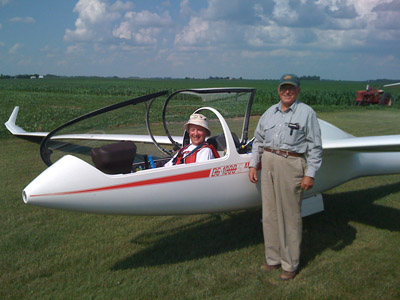 egatta
(just for fun soaring camp) in New Ulm, Minnesota. It
looked like it was going to be a great soaring day.
It started out very nice, but a storm building
nearby killed all the lift for a short time in the
mid-afternoon - forcing us to land at a lovely,
small grass farm airstrip named Turner Field Airport. The farmer,
August Turner, came out
to say hello and see if he could offer any help.
He was very friendly and seemed thrilled that we
landed on his airport. Of course, we
complimented him on how nice the runway was and how
much it had helped us out. We asked him about
his flying and he said he had a Piper cub. He
also said he flew Martin B-26 Marauder bombers in
World War II. He flew 36 missions. Wow!
Out of all the airports in MN, we just happened to
land on one owned by a WW II bomber pilot!
Cool! egatta
(just for fun soaring camp) in New Ulm, Minnesota. It
looked like it was going to be a great soaring day.
It started out very nice, but a storm building
nearby killed all the lift for a short time in the
mid-afternoon - forcing us to land at a lovely,
small grass farm airstrip named Turner Field Airport. The farmer,
August Turner, came out
to say hello and see if he could offer any help.
He was very friendly and seemed thrilled that we
landed on his airport. Of course, we
complimented him on how nice the runway was and how
much it had helped us out. We asked him about
his flying and he said he had a Piper cub. He
also said he flew Martin B-26 Marauder bombers in
World War II. He flew 36 missions. Wow!
Out of all the airports in MN, we just happened to
land on one owned by a WW II bomber pilot!
Cool!
We were able
to reach our towpilot and arrange for the club
towplane to fly over and give us an aerotow.
We asked Mr. Turner if it was OK for us to get an aerotow
out, and if he could help us tow the glider down to
the end of the runway. He then went to get a
vehicle to use to tow the glider. He came back
with an antique tractor (visible in the background
of the photo above) and kindly pulled the glider to
the end of the runway. He even ran the wing as
we took off. The soaring conditions had
improved - so we had a nice easy flight of several
hours after that. We didn't achieve our
cross-country objective, but we met a neat old pilot
who was just tickled that we landed at his airport.
What a fun adventure! As is often the case in
soaring - it's not so much about the huge flights or
big accomplishments, but more about the people you
meet.
Family
We had a good summer with everyone very busy.
My youngest daughter Sara enjoyed running track in the spring,
horse camp in the summer, and soccer this fall.
She also likes her piano lessons and singing in a
community choir. She's now in 4th grade.
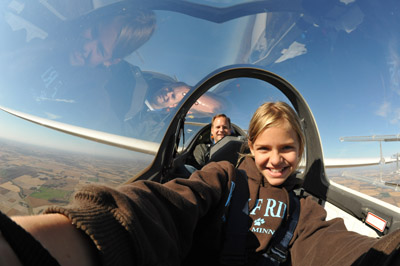 Elle has
also had a fun year. She moved up to middle
school where she is in the 6th grade. She also
plays the piano and sings in choir. Horse camp
was a huge hit with her. She's currently in
her first musical production as a chorus member.
She impressed us all with her performance in the Laker Idol singing contest last summer. The
photo at left was taken by Elle in the DG-1000 that I
own a share of. Elle has
also had a fun year. She moved up to middle
school where she is in the 6th grade. She also
plays the piano and sings in choir. Horse camp
was a huge hit with her. She's currently in
her first musical production as a chorus member.
She impressed us all with her performance in the Laker Idol singing contest last summer. The
photo at left was taken by Elle in the DG-1000 that I
own a share of.
Adam just
started high school! I can't believe he is
already in the 9th grade... Like his sisters,
he's a very sharp and friendly kid. His
biggest hobbies are reading, playing video games,
and robotics. He's involved in an amazing
robotics team at his high school.
My lovely
and brilliant wife Renee has also been busy.
She changed jobs recently. She had been
working as a public health nurse - full-time.
She now does that only 1/2 day every other week.
She also works 3 days a week as a phone triage
nurse. It is not as interesting and
challenging as her public health nursing job, but it
allows her to work 3 days a week and still get
benefits.
You can see
a few family photos here:
www.remde.us.
Fun
Family Trip
 In September I took the kids on one last
adventure before school started. The main
reason was a rather historical/nostalgic one.
Nearly every summer when I was young my family went
to a small amusement park in northern Indiana called
the Enchanted Forest. It was owned by my
father's aunt. We thought it was so cool to go
to our "Aunt Trudy's amusement park". Sadly,
the Enchanted Forest closed down in 1990. Fast
forward to 2011... This summer on the way home
from the Ionia, Michigan soaring contest, I decided
to stop to see the site that had been the home to
the Enchanted Forest. The site now was
home to many waterpark rides, but sadly, the
waterpark had recently closed. It was
surprising to me just how sad I was to see the park
empty and neglected. A few days later I did
some online research and was very happy to learn
that some of the rides from the old Enchanted Forest
had been purchased and moved to a small amusement
park near Madison, Wisconsin called Little Amerricka
- and those very same rides are still in operation!
Cool! Somehow I was glad to learn that the
rides I rode as as kid were still making kids smile.
So, on a cold and rainy day in September, I packed
the kids into the minivan and drove about 4 hours to
Little Amerricka amusement park. To be honest,
I was wondering if I wasn't a little bit crazy to
drive 4 hours to such a small amusement park that is
really for kids much younger than my kids. The
kids weren't sure whether or not they were exited
about it. But they kindly agreed to go with
me. Fortunately, despite the lousy weather, we
had a blast! The park is
home to the same, old, Mad
Mouse roller coaster (visible in the background in the photo
above) that I rode as a kid. The Scrambler ride is the same one too. And they
had many other rides that weren't from the Enchanted
Forest, but were identical to rides from the
Enchanted Forest. It was a great trip back in
time for me - riding the Mad Mouse, Scrambler,
bumper cars, and other rides. The kids
seemed to have almost as much fun as I did!
Thank you Adam, Elle and Sara - for going along with
me on this nostalgic trip. In September I took the kids on one last
adventure before school started. The main
reason was a rather historical/nostalgic one.
Nearly every summer when I was young my family went
to a small amusement park in northern Indiana called
the Enchanted Forest. It was owned by my
father's aunt. We thought it was so cool to go
to our "Aunt Trudy's amusement park". Sadly,
the Enchanted Forest closed down in 1990. Fast
forward to 2011... This summer on the way home
from the Ionia, Michigan soaring contest, I decided
to stop to see the site that had been the home to
the Enchanted Forest. The site now was
home to many waterpark rides, but sadly, the
waterpark had recently closed. It was
surprising to me just how sad I was to see the park
empty and neglected. A few days later I did
some online research and was very happy to learn
that some of the rides from the old Enchanted Forest
had been purchased and moved to a small amusement
park near Madison, Wisconsin called Little Amerricka
- and those very same rides are still in operation!
Cool! Somehow I was glad to learn that the
rides I rode as as kid were still making kids smile.
So, on a cold and rainy day in September, I packed
the kids into the minivan and drove about 4 hours to
Little Amerricka amusement park. To be honest,
I was wondering if I wasn't a little bit crazy to
drive 4 hours to such a small amusement park that is
really for kids much younger than my kids. The
kids weren't sure whether or not they were exited
about it. But they kindly agreed to go with
me. Fortunately, despite the lousy weather, we
had a blast! The park is
home to the same, old, Mad
Mouse roller coaster (visible in the background in the photo
above) that I rode as a kid. The Scrambler ride is the same one too. And they
had many other rides that weren't from the Enchanted
Forest, but were identical to rides from the
Enchanted Forest. It was a great trip back in
time for me - riding the Mad Mouse, Scrambler,
bumper cars, and other rides. The kids
seemed to have almost as much fun as I did!
Thank you Adam, Elle and Sara - for going along with
me on this nostalgic trip.
Thank You
Thank you for
taking the time to read the
newsletter. There is a lot of interesting
soaring news to report from around the world, and I
have been very busy adding new products to my web
site. I hope you will enjoy it. If
you do, please tell your soaring friends about it by
forwarding the following link to them:
http://www.cumulus-soaring.com/newsletters.htm
Would you
believe that nearly 4000 glider pilots from around the
world read this newsletter?! I am amazed and
flattered. I will do my best to keep it
interesting and worthy of the time you spend reading
it and clicking through the links.
If this is your
first newsletter - Welcome! If you missed any
of the previous issues of this newsletter, they are
all available here:
http://www.cumulus-soaring.com/newsletters.htm
Note: Click on
the small images on this page to view much larger
versions of the images.
Good Soaring,
Paul Remde
|
|
Soaring 100 |
|
Thank you Jim
and Simine for making the 2 articles below available
and supplying the photos! I wish I could have
been there.
Wright
Centennial Attracts 10,000 to Kitty Hawk
by Simine and Jim Short
 A
century after Orville Wright’s final flying
experiments at Kitty Hawk, NC, during which he
soared his newest glider to a record duration mark
of 9 minutes and 45 seconds, history fans, flying
enthusiasts and weekend visitors met at the same
spot to commemorate Wright’s achievement and the
beginning of modern soaring flight. The event,
called SOARING100, attracted over 10,000 visitors to
the Outer Banks, NC venues of Jockey’s Ridge State
Park and Wright Brothers National Memorial over the
weekend of 21 – 24 October. A
century after Orville Wright’s final flying
experiments at Kitty Hawk, NC, during which he
soared his newest glider to a record duration mark
of 9 minutes and 45 seconds, history fans, flying
enthusiasts and weekend visitors met at the same
spot to commemorate Wright’s achievement and the
beginning of modern soaring flight. The event,
called SOARING100, attracted over 10,000 visitors to
the Outer Banks, NC venues of Jockey’s Ridge State
Park and Wright Brothers National Memorial over the
weekend of 21 – 24 October.
“We were
overwhelmed by the attendance,” remarked event
chairman Jim Short. “People are still enthralled by
the Wright brothers story and excited about sport
soaring, whether with sailplanes, hang gliders,
paragliders or models.”
“The goal of
SOARING100 to complete the story of the Wrights
experiments on the Outer Banks and instill greater
interest in the role of gliders over the last
century was well-received,” added John Harris,
president of the Rogallo Foundation, one of the
partners in creating the event. “This was a
remarkable grass-roots effort that happened because
of the generosity, volunteerism and enthusiasm of
all involved.”
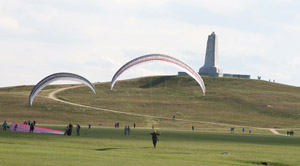 Kicking
off the event was the dedication of a National
Landmark of Soaring, coordinated by the National
Soaring Museum, at Jockey’s Ridge. The Landmark
plaque honors those who have flown the Outer Banks
dunes, including the Wrights, Francis Rogallo
(father of the modern hang glider) and current
sailplane, hang glider and paraglider pilots. Kicking
off the event was the dedication of a National
Landmark of Soaring, coordinated by the National
Soaring Museum, at Jockey’s Ridge. The Landmark
plaque honors those who have flown the Outer Banks
dunes, including the Wrights, Francis Rogallo
(father of the modern hang glider) and current
sailplane, hang glider and paraglider pilots.
An
historical symposium, coordinated by Dr. Tom D.
Crouch of the National Air and Space Museum, focused
on the role of gliders in the earliest development
of the airplane, possibly the first such event. A
“Legends of Hang Gliding” symposium, organized by
John Harris, was another first at which hang gliding
pioneers gathered to discuss the development of
their sport. “We were indeed happy that these
unique events occurred at SOARING100,” said Lola
Hilton, executive
 director
of the First Flight Foundation, the lead partner for
the event. “And there was more,” she added.
“Individual speakers included NASA Space Shuttle
pilot Susan Kilrain, National Park Service
interpreter Darrell Collins who was the National
Soaring Museum’s prestigious Barnaby lecturer and
Amanda Wright Lane, great grand niece of the Wrights
and featured speaker at the October 24 formal
recognition of the Wright record.” director
of the First Flight Foundation, the lead partner for
the event. “And there was more,” she added.
“Individual speakers included NASA Space Shuttle
pilot Susan Kilrain, National Park Service
interpreter Darrell Collins who was the National
Soaring Museum’s prestigious Barnaby lecturer and
Amanda Wright Lane, great grand niece of the Wrights
and featured speaker at the October 24 formal
recognition of the Wright record.”
Flying
sailplanes at Wright Brothers National Memorial and
hang gliders at Jockey’s Ridge State Park dominated
much of the program. At the Wright Memorial a flying
Showcase of Soaring History featured 15 specially
selected sailplanes and motorgliders, taking off
from the First Flight Airstrip and landing on the
adjacent historic ground of the National Park. After
landing the Showcase pilots became docents,
discussing soaring while showing their planes to the
throngs of visitors.
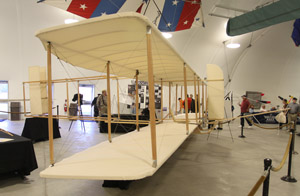 Static
displays included a just-completed replica of the
Wright 1911 glider built by Rick Young of Richmond,
VA and an as-yet uncovered version of the glider
built by family and friends in honor of the late Jim
Dayton of Mechanicsville, MD. Other displays
included significant sailplanes and hang gliders and
a World War II military gliding exhibit. A specially
created video explaining the history and context of
1911 aviation and the reasons for the Wright soaring
experiments, commissioned by the First Flight
Foundation and sponsored in part by a grant from the
Outer Banks Visitors Bureau, premiered at the Wright
Brothers pavilion. Static
displays included a just-completed replica of the
Wright 1911 glider built by Rick Young of Richmond,
VA and an as-yet uncovered version of the glider
built by family and friends in honor of the late Jim
Dayton of Mechanicsville, MD. Other displays
included significant sailplanes and hang gliders and
a World War II military gliding exhibit. A specially
created video explaining the history and context of
1911 aviation and the reasons for the Wright soaring
experiments, commissioned by the First Flight
Foundation and sponsored in part by a grant from the
Outer Banks Visitors Bureau, premiered at the Wright
Brothers pavilion.
Formalities
and speakers including Mike Murray, Superintendent
of the Outer Banks Group of the National Park
Service concluded the ceremonies on October 24.
The
Soaring 100 Celebration
by Simine and Jim Short
It is tough to say thanks to the many people and
organizations who helped in designing, creating and
then executing this wonderful event! Reading the
many entries on the web and hearing comments during
the event, it was a success, particularly in safety,
visitor experience, attendance, visual and audio
impact, personal satisfaction and relations, fun and
much more. We relayed the Wright brothers story and
tradition but we also created new interest and
appreciation of where and how motorless flight has
grown since that memorable day on October 24, 1911.
 A
rough estimate indicated that more than 10,000
people came to Wright Brothers National Memorial and
Jockey's Ridge State Park. Fifteen sailplanes were
invited to participate in the Flying Showcase of
Soaring History: a just-restored Grunau Baby
(1930s), a Schweizer TG-2 (1943), Schweizer 1-21
(1947), Schweizer 1-23 (1948), Schweizer 1-26
(1955), an Olympia IIb (1948), Schleicher Ka-6E
(1963), Glasflügel Libelle 201B (1968), Schleicher
ASW-20 (1978), Schleicher ASK-21 (1979),
Schempp-Hirth Duo Discuss (1994), Schleicher ASG-29
(2000), DG Flugzeugbau DG 808B motorglider (2000),
and the new Phoenix motorglider. Launched by a Piper
Pawnee, furnished by Bermuda High Soaring, each
glider took off from the First Flight Airstrip and
landed like clockwork on the "holy" ground (the
now-grassy area that covers the Wright brothers 1903
flight pattern). The visiting public was spellbound
seeing the gliders land and then line up for display
with docents explaining what soaring was all about. A
rough estimate indicated that more than 10,000
people came to Wright Brothers National Memorial and
Jockey's Ridge State Park. Fifteen sailplanes were
invited to participate in the Flying Showcase of
Soaring History: a just-restored Grunau Baby
(1930s), a Schweizer TG-2 (1943), Schweizer 1-21
(1947), Schweizer 1-23 (1948), Schweizer 1-26
(1955), an Olympia IIb (1948), Schleicher Ka-6E
(1963), Glasflügel Libelle 201B (1968), Schleicher
ASW-20 (1978), Schleicher ASK-21 (1979),
Schempp-Hirth Duo Discuss (1994), Schleicher ASG-29
(2000), DG Flugzeugbau DG 808B motorglider (2000),
and the new Phoenix motorglider. Launched by a Piper
Pawnee, furnished by Bermuda High Soaring, each
glider took off from the First Flight Airstrip and
landed like clockwork on the "holy" ground (the
now-grassy area that covers the Wright brothers 1903
flight pattern). The visiting public was spellbound
seeing the gliders land and then line up for display
with docents explaining what soaring was all about.
The pavilion of Wright Brothers National Memorial
housed a static display of sailplanes, which
included a Baby Bowlus (1938), a Schweizer 1-26
(1954), HpH 304 (1995), and a just completed 1911
Wright glider replica. Hanging from the ceiling were
several colorful and historically significant hang
gliders.
The original vision was to introduce the beauty of
the sport as it had evolved from Orville Wright’s
9'45" soaring flight. Talking with the SSA and
others, this was possibly the largest concentration
of soaring enthusiasts and the interested public, in
one place in the United States since World War II.
SOARING100 introduced the thought of motorless
flight to many people and hopefully will bring in
newcomers to the various sports of soaring!
|
|
LXNAV News |
New LXNAV V7
Variometer
 The
LXNAV V7 Variometer is a very sexy new digital
speed-to-fly variometer and final glide calculator -
with a built-in g-meter, FLARM traffic display and
digital logbook. It is a speed-to-fly variometer
with stepper motor driven mechanical needle (red
pointer) and bright color display - and it fits into
a standard 57 mm instrument hole. A rotary knob /
push-button is used to move through display and
setup screens and to edit parameters. The built-in 2
inch 320 x 240 pixel color display is used to
display parameters such as vario average, thermal
average, distance to goal, altitude, battery level,
speed-to-fly push/pull indicator, MacCready setting,
etc. A very cool use of the built-in color display
is a FLARM "clock" display screen. I am especially
impressed with the way the vario 20 second average
(red diamond), MacCready (blue arrowhead) and
Thermal Average (green "T") are displayed on the
inside of the vario scale - making it easy to
compare the MacCready setting to the thermal
average, 20 second vario average, and instantaneous
vario reading (red pointer). Another interesting
feature is that a The
LXNAV V7 Variometer is a very sexy new digital
speed-to-fly variometer and final glide calculator -
with a built-in g-meter, FLARM traffic display and
digital logbook. It is a speed-to-fly variometer
with stepper motor driven mechanical needle (red
pointer) and bright color display - and it fits into
a standard 57 mm instrument hole. A rotary knob /
push-button is used to move through display and
setup screens and to edit parameters. The built-in 2
inch 320 x 240 pixel color display is used to
display parameters such as vario average, thermal
average, distance to goal, altitude, battery level,
speed-to-fly push/pull indicator, MacCready setting,
etc. A very cool use of the built-in color display
is a FLARM "clock" display screen. I am especially
impressed with the way the vario 20 second average
(red diamond), MacCready (blue arrowhead) and
Thermal Average (green "T") are displayed on the
inside of the vario scale - making it easy to
compare the MacCready setting to the thermal
average, 20 second vario average, and instantaneous
vario reading (red pointer). Another interesting
feature is that a
 white
arc is displayed around the inside of the variometer
scale which indicates the maximum and minimum lift
lift/sink rates over the last 20 seconds. That will
be useful while centering thermals and deciding when
to leave a thermal. A built-in logbook feature is
also very nice. It makes it easy to update your
personal of sailplane logbook with dates (if a GPS
is connected) and flight times. A g-meter is also
built into the V7 with g indication on the vario
scale - just like a classic g-meter. A red arc on
the inside of the variometer scale can be enabled to
display the range of g readings encountered. It can
be reset manually and it automatically resets on
take-off. The small red diamond that defaults to the
display of average variometer can be configured to
display the instantaneous g reading. The V7 can
provide 5V power for a PDA or PNA. white
arc is displayed around the inside of the variometer
scale which indicates the maximum and minimum lift
lift/sink rates over the last 20 seconds. That will
be useful while centering thermals and deciding when
to leave a thermal. A built-in logbook feature is
also very nice. It makes it easy to update your
personal of sailplane logbook with dates (if a GPS
is connected) and flight times. A g-meter is also
built into the V7 with g indication on the vario
scale - just like a classic g-meter. A red arc on
the inside of the variometer scale can be enabled to
display the range of g readings encountered. It can
be reset manually and it automatically resets on
take-off. The small red diamond that defaults to the
display of average variometer can be configured to
display the instantaneous g reading. The V7 can
provide 5V power for a PDA or PNA.


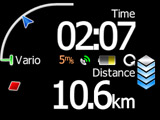
The V7 sells
for $1595 and the V7D 2nd-seat repeater sells for
$560. This is going to be a very popular unit.
I will have units in stock in a week or 2.



All the cool new features pioneered in the V7 will
quickly get into the V5 variometers that are used
with LXNAV LX8000, LX8080 and LX9000 flight
computers.

Details
LXNAV AHRS
LXNAV now offers a new AHRS (attitude and heading
reference system) for use with their flight computer
systems. It is a 1200 € (about $1680) option. The LX
Styler software can be used to place and size the
AHRS display on any screen on your LX8000, LX8080 or
LX9000.
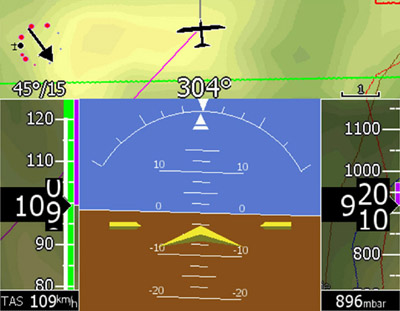
Details
LXNAV
Nano - Free software upgrade
 A
free software upgrade is available for the LXNAV
Nano. When you connect your Nano to your PC
and run the Nano configuration software it will tell
you if your configuration software or Nano firmware
need updating. It will also take care of the
update for you. If the software doesn't
show any version checks, then you may need to
upgrade the PC software manually. You can
download the NanoConfig software directly onto the
memory card in the Nano. The software is
available here:
http://www.lxnav.com/download/software.html A
free software upgrade is available for the LXNAV
Nano. When you connect your Nano to your PC
and run the Nano configuration software it will tell
you if your configuration software or Nano firmware
need updating. It will also take care of the
update for you. If the software doesn't
show any version checks, then you may need to
upgrade the PC software manually. You can
download the NanoConfig software directly onto the
memory card in the Nano. The software is
available here:
http://www.lxnav.com/download/software.html
The new
version offers several advantages - such as
increased battery duration of 28 hours - so I highly
recommend doing the upgrade.
Details
|
|
Zulu
Romeo - Good Start
|

Zulu Romeo - Good Start is a wonderful soaring
documentary from the 1974 World Gliding
Championships in Waikerie, South Australia. In
2010 I received a DVD copy of it from a soaring
friend. The person that gave him the copy said
that the film could not be sold, and that original
legal copies could not be made because the masters
were destroyed by fire. I tried to
find anyone associated with the film but did not
have any luck. I therefore decided to make
free copies available to customers that ordered $100
or more of product from me in a single order.
It was a nice way to say "Thank you for your
business." I started including the DVDs in mid
2010. I have sent out hundreds of them since
then. The response has been overwhelming!
I have received very warm thank you notes from
glider pilots around the world. Some of the
comments were along the lines of "I was there.
I hadn't seen the film in many years.
Thanks!". It has been fun to share this bit of
soaring history with fellow glider pilots.
 It
is a great film. If you love "The
Sun Ship Game", you'll also love this
film. It has many soaring legends in it: Helmut
Reichmann and his wife Heidi, George Moffat and his
wife Suzanne, Ingo Renner, Tommy Beltz, Hans-Werner
Grosse, Klaus Holighaus, etc. It does a great
job of documenting the excitement of the contest,
but my favorite feature of the film is the way they
ask the same questions of many pilots, and get many
very different answers. "Is physical
conditioning important?", "Is the crew as important
as the pilot?", "Are you flying for your country, or
yourself?", etc. The answers really give
insights into the minds of the competitors. I
love this film. I will continue to send it
along with large orders for some time to come.
I can't sell you a copy, so please don't ask. It
is a great film. If you love "The
Sun Ship Game", you'll also love this
film. It has many soaring legends in it: Helmut
Reichmann and his wife Heidi, George Moffat and his
wife Suzanne, Ingo Renner, Tommy Beltz, Hans-Werner
Grosse, Klaus Holighaus, etc. It does a great
job of documenting the excitement of the contest,
but my favorite feature of the film is the way they
ask the same questions of many pilots, and get many
very different answers. "Is physical
conditioning important?", "Is the crew as important
as the pilot?", "Are you flying for your country, or
yourself?", etc. The answers really give
insights into the minds of the competitors. I
love this film. I will continue to send it
along with large orders for some time to come.
I can't sell you a copy, so please don't ask.
Recently I
received the note below from the producer of the
film.
I
produced and directed the ZRGS documentary
nearly thirty seven years ago and I would love
to show a copy to my kids. The original masters
were destroyed in a fire some twenty years ago
and I nearly fell over when I came across the
various ZRGS discussion posts totally by
accident.
We shot the film on 35mm which is why the
original was of such high quality. Of course
that poses problems with the equipment you have
to lug around to support the format but it was
worth it. The crew and I had a wonderful couple
of weeks living in the lap of so many really
great characters, Helmut Reichmann, Ingo Renner,
George Moffat - the list goes on.
Our helicopter pilot was cool as a cucumber and
from day one the sailplane pilots trusted him
implicitly to maintain the pre-planned
separations. They all used to take it in turns
to snuggle up under our portside where John
Haddy the cameraman operated the Tyler 35mm
camera mount with me hanging out on a safety
line to act as a windshield for the zoom lens !
I was saddened
to learn of Helmut's death in the nineties. He
and Heidi and I became good friends and we
visited them in Saarbruken on a number of
occasions in later years. The writer, my good
friend Peter Wier, was killed in a parachute
accident also in the nineties. Gee it brings
back a lot of memories. If I
could get hold of a DVD I would be very
grateful.
Kind regards,
Johnnie Walker
Of course, I
sent him a copy immediately and asked him to send me
more information about the film. As a fan of
the film, this was getting very exciting! The
very next day after responding to him in an e-mail,
he sent me the notes and images below.
 Hi
Paul, Hi
Paul,
You've no idea what a thrill it is to track down
a copy of the ZRGS doco after all these years.
The power of the internet ! I remember the
documentary was a major undertaking for us at
the time as we were a small boutique film
production company, Picadilly Picture
Corporation, mainly specialising in high end
film and TV commercials.
Over a few beers after work one Friday night in
1974, I recounted a conversation I had had
during the year with a glider pilot in Germany
who had talked enthusiastically about the
forthcoming world championships to be held at
Waikerie in South Australia.
 As
cameraman John Haddy and sound recordist Ron
Green and I were partners in the film company,
we sort of looked at one another, nodded in
agreement, had a couple more beers and started
to work on a production plan over the weekend.
The three of us had all worked extensively
overseas in Europe and Asia and always had a
leaning towards a high quality 35mm format.
Having talked John Haddy out of trying to do a
70mm widescreen epic, we did our schedules,
worked out our equipment lists, talked to Peter
Clemence, a superb helicopter pilot who both
John and I had used previously in Hong Kong,
hooked in Peter Wyer from a client ad agency as
our writer, purchased an eight berth caravan
with tent extensions, an SUV to tow it and
several dozen cases of Victorian beer. As
cameraman John Haddy and sound recordist Ron
Green and I were partners in the film company,
we sort of looked at one another, nodded in
agreement, had a couple more beers and started
to work on a production plan over the weekend.
The three of us had all worked extensively
overseas in Europe and Asia and always had a
leaning towards a high quality 35mm format.
Having talked John Haddy out of trying to do a
70mm widescreen epic, we did our schedules,
worked out our equipment lists, talked to Peter
Clemence, a superb helicopter pilot who both
John and I had used previously in Hong Kong,
hooked in Peter Wyer from a client ad agency as
our writer, purchased an eight berth caravan
with tent extensions, an SUV to tow it and
several dozen cases of Victorian beer.
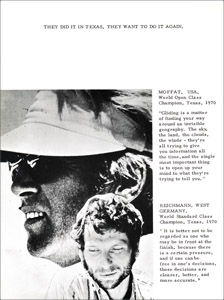 The
gig cost us well over $140,000 which was a lot
of money in those days but you know how it goes
when you are young and silly: "get your motor
running, get out on the highway etc . ." Well in
this case it was the skyway. We lived and
breathed soaring for the next fortnight and then
the convoy left for Waikerie about 800 miles
away in the top corner of the Victorian/South
Australian border. (It's huge vista type country
where we had shot a series of GMH car & Fosters
beer commercials the year before on a 77,000
acre sheep and cattle property that sat on both
sides of the border line). The
gig cost us well over $140,000 which was a lot
of money in those days but you know how it goes
when you are young and silly: "get your motor
running, get out on the highway etc . ." Well in
this case it was the skyway. We lived and
breathed soaring for the next fortnight and then
the convoy left for Waikerie about 800 miles
away in the top corner of the Victorian/South
Australian border. (It's huge vista type country
where we had shot a series of GMH car & Fosters
beer commercials the year before on a 77,000
acre sheep and cattle property that sat on both
sides of the border line).
As all the competing planes and crews started to
arrive for practice week, the aerodrome took on
the feel of a medieval jousting tournament.
Banners, pennants and flags fluttered on tent
poles, eating halls, fuel trucks, tug aircraft,
recovery wagons with their crews studying
detailed maps in English. Pilots plotting
courses using the huge wheat silos dotted about
the countryside as on course marker points. And
above us all, a blazing blue sky with white
puffs of what we came to know as cumulus clouds.
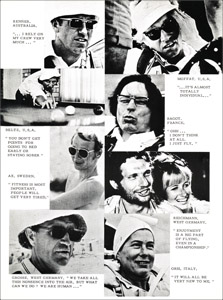 Our
arrival caused a great stir around the tent and
caravan city camped on the aerodrome because a
full blown 35mm production is not low key nor is
it for the faint hearted. Several camera crew, a
jib-arm camera crane for elevated ground work,
camera dollies and tracks for set up stuff,
lighting truck, grip truck, camera truck with
refrigerators for the film stock and, in the
middle of this circus, a glistening Bell 5 seat
helicopter equipped with a floating gimbal Tyler
camera mount and harnesses for the cameraman and
the director where the door used to be. Our
arrival caused a great stir around the tent and
caravan city camped on the aerodrome because a
full blown 35mm production is not low key nor is
it for the faint hearted. Several camera crew, a
jib-arm camera crane for elevated ground work,
camera dollies and tracks for set up stuff,
lighting truck, grip truck, camera truck with
refrigerators for the film stock and, in the
middle of this circus, a glistening Bell 5 seat
helicopter equipped with a floating gimbal Tyler
camera mount and harnesses for the cameraman and
the director where the door used to be.
For a while there during practice week it seemed
nearly everyone around the aerodrome and from
the town itself were hovering around watching us
work, getting our master shots of pilots
briefings, recovery crews on walkie talkies, tug
pilots getting used to individual preferences,
filming the race preparations and gathering some
pre-race cameos. Like George and Susan Moffat
patching their high performance plane with our
silver backed 'gaffer tape', young guns like
Tommy Beltz looking cool, affable quietly spoken
heros like Helmut Reichmann, Heidi Reichmann
always with an umbrella over the cockpit,
wonderful local hero Ingo Renner trying to keep
a low profile and not to let hometown hype cloud
his judgement. The not to be named Australian
glider pilot/farmer who added a little something
else to his wing tanks so that on his low swoop
flyover at the opening ceremony he could spray
the diluted mixture over the crowd of
politicians. I think we laughed and laughed
until our sunburns crackled. The French with
their sausage and cheeses. The meticulous and
hard working German support crews who loved to
have a beer with us as the sun went down and all
their planes were safely home. Not to mention
the troupes of various young ladies also enjoyed
our nightly crew bar-b-ques and aforementioned
cases of Victorian beer.
 The
racing itself was really exciting and I think
the doco captures all of that. At least I think
it did last time I saw it about 35 years ago! I
remember at the time that John and I felt we had
taken the 'air to air' stuff to a new level.
Lots of practice in factory Boeings over
Seattle. Our helicopter pilot was cool as a
cucumber and from day one the sailplane pilots
trusted him implicitly to maintain the
pre-planned separations. They all used to take
it in turns to snuggle up under our portside
where John Haddy the aerial cameraman operated
the Tyler 35mm camera mount with me hanging out
on a safety line to act as a windshield for the
zoom lens ! And of course Peter's wonderful
voice over and laconic comments gave the film a
whole dimension. The
racing itself was really exciting and I think
the doco captures all of that. At least I think
it did last time I saw it about 35 years ago! I
remember at the time that John and I felt we had
taken the 'air to air' stuff to a new level.
Lots of practice in factory Boeings over
Seattle. Our helicopter pilot was cool as a
cucumber and from day one the sailplane pilots
trusted him implicitly to maintain the
pre-planned separations. They all used to take
it in turns to snuggle up under our portside
where John Haddy the aerial cameraman operated
the Tyler 35mm camera mount with me hanging out
on a safety line to act as a windshield for the
zoom lens ! And of course Peter's wonderful
voice over and laconic comments gave the film a
whole dimension.
It was screened on the BBC a couple of times in
prime spots, on German ZDF a couple also. On ABC
television in Australia. And that was about it.
Our planned sales in the US didn't ever get off
the ground, so to speak, because apparently we
missed the buying season in the US and after
that it was too late. Bit of a shame really as
we lost a bucketful of money on the venture.
 But
on the other hand Paul, it was worth it to us
because the soaring fraternity loved it. It made
people happy and we made lots of friends. Our
special thanks to a family in town who provided
great hospitality and unfortunately we can only
remember the lady of the house as Patricia Palm
Trees in memory of the trees that lined the
driveway as we lurched back to the aerodrome
after dinner. And thats what's life is all about
isn't it ? Friendship and the bonds it creates. But
on the other hand Paul, it was worth it to us
because the soaring fraternity loved it. It made
people happy and we made lots of friends. Our
special thanks to a family in town who provided
great hospitality and unfortunately we can only
remember the lady of the house as Patricia Palm
Trees in memory of the trees that lined the
driveway as we lurched back to the aerodrome
after dinner. And thats what's life is all about
isn't it ? Friendship and the bonds it creates.
I was saddened to learn of Helmut's death in the
nineties. He and Heidi and I became good friends
and we visited them in Saarbruken on a number of
occasions in later years.
By the way, I don't worry about you personally
giving copies of ZRGS away. I am delighted that
you and your customers find it such a useful
promotional item! But I would like in future for
you to slip a note on the pack saying that it is
for their personal use only and should not be
used for public screenings without first
emailing me for permission. As the owner of the
copyright for such screenings, permission will
not be unreasonably withheld. (Of course.
I'll be glad to include the note. - Paul)
Kind regards and all the very best .
Johnnie Walker
PS - Bit of a sobering thought: all the main
members of the crew except me have passed away.
Vale:
John Haddy - Cinematographer
Ron Green - Sound Recordist
Peter Wyer - Writer
Barry Halloren - Senior Grip
Stuart Springer - Lighting
Peter Clemence - Helicopter Pilot
The note
below was sent after 5 or 6 e-mails that included
the wonderful images above.
There we
go Paul.
A few bits of pictorial material from a draft
sales brochure. Whew. This is like dredging up a
part of my life that I thought had been
destroyed in a fire at my film editor's
offices/storage basement about twenty years ago.
All my film masters were lost - about fifteen
years of commercials, documentaries, three
feature movies and several TV series episodes.
It was such a tragedy. And now here's a blast
from the past. Can't wait to get a copy Paul.
I'm very grateful.
Kind regards
Johnnie
Thank you
Johnnie for sharing that fascinating look into the
making of the film!!! Thank you also for the
many images you sent and I have included here.
But mostly, thank you for your hard work making the
film. It is obviously something you are very
proud of - and you should be! It is great to
be able to contribute (in a small way) to the
documenting of this piece of soaring history.
Now I imagine
that many of your are sitting on the edges of your
seats, wanting to watch this film! I wish I
could sell you a copy. I can't do that, but I
can give you a free copy with your next order of
$100 or more. Of course, I'm flexible on that
number - especially for customers that have
purchased a lot from me in the past - and for
soaring friends. However, I do recommend that
you e-mail me to remind me to include the film.
I hope you
enjoy the film as much as I do. Please feel
free to send me an e-mail if you have any connection
with the film. I'm always interested.
I imagine
Johnnie would welcome friendly notes about the film.
He can be reached at johnnie at walkerco dot
com dot au.
|
|
Holiday Gift Ideas |
|
Are you looking
for some low cost items to give to soaring friends,
or gifts to ask for from you friends or loved ones?
Below are a few ideas.
|
|
SPOT 2 $50 Mail-in Rebate -
May 1
to December 31 |
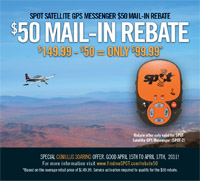 SPOT
is offering a nice incentive to buy a SPOT 2 this year. It is a $50
mail-in rebate that is only available from May 1st through December
31st, 2011. It only applies to the SPOT Satellite GPS Messenger (SPOT 2)
- not the SPOT Connect. You pay the normal $149.95 price for the
hardware and use the mail-in rebate form (along with a copy of your
invoice and the box bottom) to get $50 back in the mail. SPOT
is offering a nice incentive to buy a SPOT 2 this year. It is a $50
mail-in rebate that is only available from May 1st through December
31st, 2011. It only applies to the SPOT Satellite GPS Messenger (SPOT 2)
- not the SPOT Connect. You pay the normal $149.95 price for the
hardware and use the mail-in rebate form (along with a copy of your
invoice and the box bottom) to get $50 back in the mail.
Details
|
|
SeeYou
Version 4.2 Available Soon |
Naviter will
soon be releasing an cool new version of SeeYou for
the PC.
It is definitely worth the $83 upgrade price, but I
suppose I'm biased because I sell it. You can
see the new features in the image below.

The new features in SeeYou 4.2 are summarized
below.
- Pictures Gallery
The new picture gallery makes it possible to view photos from your
flight the progress through while you view the flight log. You can
drag and drop pictures from your flights to SeeYou and the pictures will
be automatically referenced to your flight. This will work "out of the
box" provided that camera time and UTC offset in SeeYou are setup
correctly. If camera time was inaccurate it's still possible to
adjust it through Edit > Flight properties > Photos. It's great
fun to browse through your old in-flight pictures and reference them to
the flights in which they were taken. Flights that may have been
somewhat boring to watch in SeeYou now become exciting because you now
will see your good pictures from the cockpit to view along with the
flight log. A new ".igcx" file format has been created to make it
easy to manage the flight logs and images in a single file. Using
the new file format you can save your flight data as an "igcx" file and
send it to your friends. They can then enjoy both pictures and the
flight track from your flight by opening the single file with SeeYou 4.2
(or higher). This is a very exciting new feature! It will
really amp-up the fun of sharing flight logs with soaring friends - and
reliving your favorite flights of the past.
- Instrument Panel
The new instrument panel shows the Winter instruments (altimeter,
variometer and airspeed) for the flight you are replaying. The
instruments are, of course, available for all available units (altimeter
in feet or meters, ASI in km/h, knots or mph, vario in m/s, knots or
fpm).
Customers who already own a license for
SeeYou version 4.x can download the upgrade for free from
www.naviter.si.
If you are using an older version of
SeeYou, you can upgrade to version 4.2 for $83 here:
SeeYou-Upgrade. If you do
not own a
license for SeeYou, you can purchase one for $155 here:
SeeYou.
Details
|
|
PowerFLARM Update |


PowerFLARM
Portable Status
Many PowerFLARM Portable units have been shipped to
customers. The customers who haven't received
their PowerFLARM Portable units should receive them
in the next week or 2..
PowerFLARM Portable Hardware Upgrades
FLARM will be sending out instructions in the
next few weeks on how to send your PowerFLARM
Portable in for upgrade. The upgrade is
necessary if you received one of the units in the
first batch. The upgrade includes some
upgrades to internal components, antenna changes and
a software upgrade.
PowerFLARM Brick Status
The latest news from FLARM is that they plan to have
PowerFLARM Brick prototypes at the SSA Convention.
I still am hoping that we will have units to sell
and deliver at the SSA Convention - but I imagine
that is unlikely.
Customer
Feedback
The great news is that glider pilots that flew with
PowerFLARM at the Uvalde soaring contest gave it
overall very positive reviews. Despite the
antenna issues, it enhanced safety dramatically and
was very easy to use.
PowerFLARM Firmware Upgrade
Version 1.04 of the PowerFLARM firmware is available as a free upgrade.
It improves ADS-B reception and Mode S reception. I can now see nearby
ADS-B traffic on the display with the unit sitting
on my office desk. I can't wait to fly with
it!
Please read
completely the upgrade instructions.
Upgrade Instructions:
PF_Update_104_en.pdf
Firmware File:
PF1.04_2593.fw
- To download the file, right-click on it and select "Save Target
As...". I recommend saving it directly to a
microSD memory card.
The latest
PowerFLARM news is always available here:
http://www.cumulus-soaring.com/flarm.htm
|
|
ClearNav News
|
|
 ClearNav
Variometer Update August, 2011 ClearNav
Variometer Update August, 2011
The ClearNav variometer is getting closer to
being available. Below are the latest
photosfrom the ClearNav web site.
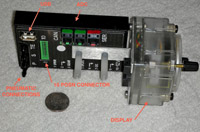

The latest word
is that they expect to be able to start shipping
units to customers in early 2012. I look
forward to seeing it at the SSA Convention - if not
earlier. You can see the latest news on their
web site here:
http://www.clearnav.net/main/cn-vario_status.html
Quite a few
customers have pre-ordered units. I can't wait
to fly with one.
Details
 ClearNav
Flight Computer News ClearNav
Flight Computer News
A new software version for the ClearNav Flight
Computer became available in September of 2011. It
includes:
- OLC
Support
- OLC
distance achieved during the flight may be
displayed
- Easier
more intuitive Task Entry/Selection/Edit. The
Task List tab has been moved to the Ribbon Menu.
- New
Pilot Selected Display Options Available:
- L/D
to Active Waypoint
-
Achieved L/D current glide
-
Speed to Fly for MC setting, glider weight
and glider polar
- GPS
Ground Speed
-
Achieved Distance on Task
-
Wind Component(HW/TW)
-
Time of Day
-
Track Error
- Added
map zoom level of 15 mi, nm, km to reduce screen
clutter
- TAT
last turn area - predicted total task time if
turn now
- SUA
color fill on/off option
-
Password Protected Pilot Profile (for club
gliders)
Details
|
|
Italian Vintage Sailplanes |

I am a big fan
of the Martin Simons "Sailplanes"
series of books. It is fascinating to read
about the history of the sailplanes and sailplane
designers and builders of the past.
This new
book is not by Martin Simons, but it is a similar
book. It will be in stock in a few days.
Below is a
review by Martin Simons.
This beautiful book is an important
contribution to the history of soaring in Italy. It fills a gap in the
literature of this subject, drawing favorable attention to the work of
Italian sailplane designers, constructors and pilots.
In the English speaking world little has
been known of them hitherto. Here is the climax of years of careful
study and research by Vincenzo Pedrielli, the author.
It will become recognized as essential
for anyone who is fascinated by the story of the Italian gliding
movement as it paralleled the extraordinary worldwide growth of this
sport.
It is clear now that designers such as
Luigi Teichfuss, whose aircraft for the first time are fully described
here, and other engineers such as those of the Aeronautica Lombarda and
the students of the Milan Polytechnic, made important contributions
before 1939. The Morelli brothers
at the Gliding Centre of the Polytechnic of Torino, founded in 1952, and
Edgardo Ciani with his extraordinary Spillo of 1954 and later designs,
were fully up to date or even ahead of their contemporaries in other
European countries, Japan and the Americas. Italian sailplane designers
are now getting the recognition they fully deserve. It is
impossible now to see these splendid, and sometimes not quite so
splendid, aircraft flying, nor can pilots hope to climb into their
cockpits and take off. They can, however, be flown in smaller form.
Francesco Camastra’s accurate drawings and the photographs included will
be an invaluable resource for model makers who until now have had very
little access to detailed information of this kind.
Vincenzo and Francesco, thank you!
Martin Simon
Details
|
|
Soaring Cafe |
 SoaringCafe.com
is a great resource for gliders pilots. It
started in January of this year and has really
"taken off". Creators Bill Elliott and Rand
Baldwin have provided many interesting and timely
soaring news articles. They do a great job of
searching for and creating interesting soaring
articles from around the world. Well done Bill and
Rand! SoaringCafe.com
is a great resource for gliders pilots. It
started in January of this year and has really
"taken off". Creators Bill Elliott and Rand
Baldwin have provided many interesting and timely
soaring news articles. They do a great job of
searching for and creating interesting soaring
articles from around the world. Well done Bill and
Rand!Below are
links to my favorite recent articles on
SoaringCafe.com:
A season in the sun – 12
contests in one year - by Frank Paynter
SOARING100 Introduces 10,000
to the History and Sport(s) of Soaring
Concordia Update: Ailerons,
Flaps, and Winglets
Gliders Used in 1948 Arctic
Rescue
Re-Dedication of Barnaby Plaque at Wright Brothers
National Memorial
Deviations, Part I
- by John Cochrane
Flying TATs with ClearNav
Concordia: First Assembly of
Wings to Fuselage
PowerFlarm Installations at
UvaldeGlide
back to the sertão
Yet Another (!) U.S. Record
Wave Flight by Boettger and Bennett
In Memoriam – Kai Gertsen
A few of Kai's excellent soaring articles are
available as free downloads:
Intro To Cross-Country
Soaring
Off-Airport Landings
|
|
WA - The Life of Soaring Legend Wally Scott |

Overview
The life story of Wallace A. Scott, who during his 36 years of soaring
pushed the limits of how far one can fly without an engine. His Texas
childhood and his families movie theater business set the roots for an
adventurous life. He learned to fly in a J-2 and continued his flying
career in the US Air Corps during WWII. He came to soaring later in life
but quickly made up for the missed years by starting his quest for long
distance records within a few years after learning to fly a glider. He
became a pioneer of free distance, straight out flight and won 4 FAI
international records, 20 Lewin A. Barringer Trophies for longest
flight, and numerous other awards. The book incorporates Wally’s own
words by using his personal journals and Soaring magazine articles as
well as interviews with his wife Boots. In addition to his lifelong
romance with flying, there are many other facets to this man, called the
‘John Wayne of soaring’, that make this book a fascinating addition to
your soaring library.
- 20-time Winner of the Lewin A.
Barringer trophy
- Two-time Winner of the Smirnoff
Derby (cross-U.S. sailplane race)
- Set 4 World Soaring Records
- Wally's Longest Flight in a
Sailplane: 808 miles (1300 km), Out & Return Flight, July 14, 1995
Review by Paul Remde
Wally Scott was an amazing man. Author Samantha did a fantastic job of pulling
together material from several sources and creating a nice, easy-to-read
summary of Wally's life and major accomplishments. I'm sure many
current soaring pilots knew Wally as the pilot that George Moffat
battled and beat in the classic film "The
Sun Ship Game". He flew a huge ASW 12 with great skill in that
film. He was a tough competitor, but mainly he enjoyed
long-distance record flights. It is remarkable that he had the
longest flight of the year in the U.S. for 20 years out of his 36 years of flying
sailplanes! I enjoyed reading about his early life, experiences
flying C-47's in World War II, and his adventures in sailplanes -
especially his articles as printed in Soaring magazine. It is
certainly a motivational book! It has me excited and enthused to
do more long soaring flights myself!
Details
|
|
Vintage Soaring
Links |
|
I
just love old soaring photos and videos. I'll try to
include a few here each month. The links below
were supplied by the Vintage Soaring News e-mail
list sent out by Josh Knerr. Thanks for
sending all the great links and photos Josh!!!
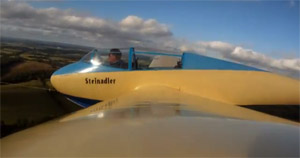
Chris Wills Memorial Flypast
The flypast from the Chris Wills Memorial Day,
Lasham Airfield, 25th June, 2011
Chris Wills was a famous British glider pilot and
founder of the Vintage Soaring Association. He
passed away in May of 2011.
http://www.youtube.com/watch?v=za-oyPoLRGE
VSA
Classic Sailplanes Group on Facebook
For those of you who are part of the Facebook
generation, the youngest branch of the VSA (the
classics) now has its own Facebook page! share
you're pictures, videos, events, thoughts, and
gossip... And make sure you click on "like" to let
all your friends know about us! Check the link
below! - Josh
http://www.facebook.com/pages/Classic-Sailplanes-VSA/211411455557906?ref=hnav

Neat old
magazine cover
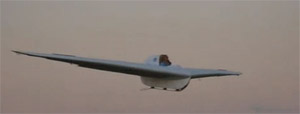
Horton H-1-B in Argentina
http://www.youtube.com/watch?v=UVnwPEnSLuM
http://www.youtube.com/watch?v=d3ceUvOOLiE
http://www.youtube.com/watch?v=AJso4Rho3ek
http://picasaweb.google.com/109995428349053173734/HortenHo1B?gsessionid=pdSFdyfcWZhBMI1yJnpTPA#
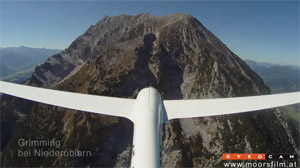
The last flight of Hanna Reitsch
In June 1978, Hanna Reitsch made her last great
flight over the Alps. With 66 years to succeed in a
final personal best. Hanna Reitsch would fly as far
as any glider pilot before. This is a reconstruction
of her last great flight for a TV portrait of Hanna Reitsch in September 2010.
http://www.youtube.com/watch?v=AZJtE9Q8WFU
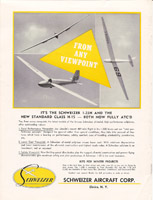
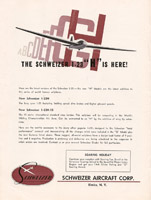
Schweizer 1-23h ads in Soaring magazine,
September 1960, sent by Cam Martin
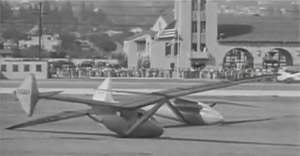
Bowlus-duPont
Albatross & Dragonfly, and a Franklin PS-2 at Grand
Central Air Terminal in Glendale - Link sent to
VSA by Raul Blacksten
http://www.youtube.com/watch?v=Y7mckQmqz7w
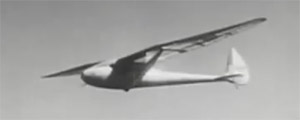
A newsreel of Richard Dupont setting a new USA
glider distance record in 1933 - flying at Big
Meadows.
- Link sent to VSA by Raul
Blacksten
http://www.youtube.com/watch?v=wC3H3EDRKcM
|
|
Torgoen Swiss Professional Pilot Watches |
Torgoen Overview by
Paul Remde
I have been a fan of fine watches for many years. I can't seem to
justify spending $4000 to $8000 on some of the wonderful pilot watches on
the market today. The Torgoen watches capture the spirit of those
watches - at a fraction of the price. They are not cheap replicas,
they are Swiss quartz watches that don't pretend to be anything they are
not. They don't feature screw-down crowns or sapphire crystals or
automatic mechanical winding mechanisms, or sweep second hands, but they are
priced so you can buy 5 or 10 of them for the same price as a single high
end pilot watch. I love the large faces (40 mm diameter crystal) and
simple, understated, classy designs. My favorites are the
T10 watches.
Their dials seem to be inspired by the watches from Bell & Ross and Sinn and
actual aircraft clocks from years gone by. I plan to mount T10301
watches on the instrument panels in the DG-1000S sailplane I fly. Their simple
design with black face and large white markings fit in perfectly - looking a
lot like a Winter variometer or altimeter or airspeed indicator.
|
Torgoen Watches - Made to Look Like Aircraft Instruments |
 |
 |
 |
 |
Torgoen T10301 Watch
my
favorite |
Winter Variometer |
Torgoen T26101 Watch |
Winter Altimeter |































My 4 Favorite Torgoen Watches




Details
|
|
New
Employee |
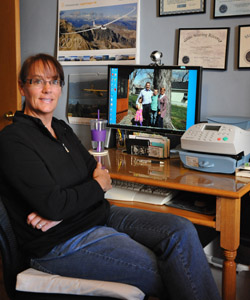 On
June 3rd of this year Kristine Swan joined the team
here at Cumulus Soaring, Inc. Kristine takes
care of shipping and receiving and general office
organization. She's doing a fantastic job and
has a great "Can do.", "How can I help?" attitude.
She lives nearby in Savage, Minnesota and is a wife
and mother of 2 wonderful children. On
June 3rd of this year Kristine Swan joined the team
here at Cumulus Soaring, Inc. Kristine takes
care of shipping and receiving and general office
organization. She's doing a fantastic job and
has a great "Can do.", "How can I help?" attitude.
She lives nearby in Savage, Minnesota and is a wife
and mother of 2 wonderful children.
Both Kristine and my wife
Renee will be helping out in my booth at the SSA
Convention in February. Thank you Kristine for
taking care of the other stuff so I can focus on
customer support and marketing!
|
|
GliderSource.com |
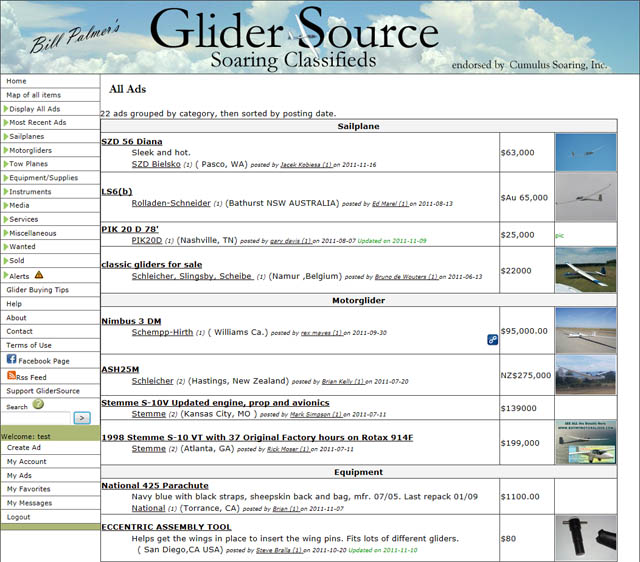
GliderSource.com
is a very impressive site created by glider pilot
Bill Palmer to make it easy to sell any used soaring
item - sailplane, motorglider, towplane, flight instrument,
parachute, PDA, trailer,
anything. The site is database driven, making
it easy to search for anything you are looking for.
I had
previously hosted a similar site at
www.soaring-classifieds.com.
But Bill's site is much easier to use, both for the
buyer and seller, and it is much more powerful and
automated. Therefore, my site now points to
his site.
I have no
business relationship with Bill - other than buying
an ad on his site. I fully endorse and
recommend it. It is a fantastic resource for
glider pilots.
My
favorite things about the site:
- Sellers can create ads
with links and photos and even videos very quickly and easily -
less than 5 minutes
- Buyers can find items
quickly because the site is very well organized
and you can search on key words.
- Pages dedicated to
categories make it easy to see only the types of
items you are interested in.
- Buyers can learn
instantly and automatically of new items for
sale by signing-up for e-mail or Facebook
notifications of new items for sale. That
way you can grab the item you want before it
sells to someone else.
- View all for sale items
on a map

- Free resources such as
glider buying tips
- Very easy to manage
existing ads
What does it
cost? Bill does not charge for the site, but
he does kindly ask for a small donation after you
sell an item. It is not required, but it is a
great way to thank him for his wonderful efforts.
Below is a
more complete list of the cool features of the site.
- Instant ad creation
with virtually unlimited room to write your ad
- Rich-text formatting
(text formatting, bullets, underline,etc) to
enhance the readability of your ad
- Multiple large photos,
super easy to upload, automatically re-sized to
fit the ad space.
- Video - include your
YouTube video right in the ad
- Links to other websites
- if you already have a web site for the item,
link directly to it
- Total ad control 24/7 -
edit all aspects of the ad, turn on and off,
mark sold
- No fixed expiration
dates - ads run as long as you need them to
- Powerful search (text,
author, manufacturer, Google map) - making it as
easy as possible for readers to find your ad
- Share buttons - helping
you get the word out about your item
- Contact form - built in
message functions, making it easy for buyers to
contact you
- Automatic instant email
notification - subscribers instantly notified of
new listings, subscribe and get the jump on new
items
- RSS feed - subscribe to
the most recent items list using an RSS reader
like my.yahoo, iGoogle, and many more.
I hope you
will find this new resource as useful and handy as I
do. Please try it!
Go There Now
|
|
Segelfliegen
Magazine |
 There
is a new digital soaring magazine available called
Segelfliegen. The Editor in Chief is Helge
Zembold. The first English language version
was released in October. You can see details
and order it here: There
is a new digital soaring magazine available called
Segelfliegen. The Editor in Chief is Helge
Zembold. The first English language version
was released in October. You can see details
and order it here:
http://www.segelfliegen-magazin.de/
The cost is
7 € (Euro) (about $10) for each issue. Payment
is done using PayPal.
It is my
impression that the print version of Segelfliegen
has been published in Germany for several years.
This international English language digital version
is new.
I purchased
a copy and was very impressed. It contained
good, timely information and interesting articles
and very nice photographs. I particularly liked the
article on the DG-1001TE and the one on Gordon Boettger's 2256 km flight. Actually, there
were many, many excellent articles in the 69 pages.
It is a high-quality publication. The artworks
and layout are fantastic. The best comparison
I can think of is the British Gliding Association's
magazine "Sailplane & Gliding".

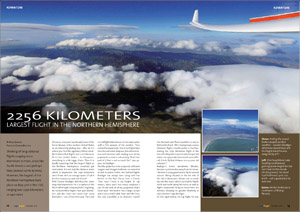
The only
minor complaint I have regarding the digital content
is that it is very difficult to print it. I
prefer to print publications like this and read them
while relaxing on the couch or while eating
breakfast. I tried printing using both the
online (web browser) reader and the downloaded Zinio
reader. In both cases, it does not allow me to
print the entire document. I would need to
print each page individually - which would take a
long time. I find that very frustrating.
I paid good money for it and I want to have a nice
printed copy. Certainly, one could argue that
digital content should not be printed - to reduce
the use of paper. I understand that, but I'd
prefer to be able to print it. I guess it is
just that when I'm sitting at my computer, I'm
working. It is not as comfortable sitting at
my computer as it is sitting on the couch. I
don't like watching TV shows on my computer either.
I prefer the comfort of my couch. I guess the
ultimate solution would be to make it possible to
buy a glossy, printed version and have it mailed to
me. It is an excellent magazine and I'd be
willing to pay extra for a printed copy. I
have spent far too much text complaining about this
minor issue.
Did anyone
besides me catch the irony in the paragraph above?
I'm laughing at myself because I'm complaining about
printability while writing in my own digital online
newsletter. However, I would argue that my
newsletter is easy to print if you want to - but
then you'd lose the ability to click through all the
great links to interesting soaring sites and
products. And you wouldn't be able to see all
the high-resolution images (nearly every image in
this newsletter can be viewed in high resolution by
clicking on it). I'm sorry for my
contradiction. I guess I feel that their
publication would work well in printed form while
mine is really best read online. Maybe that
makes me old fashioned...? Maybe next time
I'll create my newsletter as a PDF file that
can be printed, but with working links.
Segelfliegen
is a great magazine. I highly recommend it!!!
Details
|
|
Silent
Flight Wines |

 Silent
Flight Wines is a South Australian based owned &
operated Wine Distributor. Silent
Flight Wines is a South Australian based owned &
operated Wine Distributor.
Inspired by the 'free-flying spirit', this wine was
produced to be stocked airfield bars across the
country to give the Aviation Industry a wine that
was crafted for them. This is how Silent Flight
Wines was born.
We have our well loved, 'First Solo 2007 Shiraz' for
sale on our online webshop. This Shiraz is the first
to be released under the Silent Flight Wines label.
It is a smooth Shiraz that has been aged in American
oak. Full flavour with hints of vanilla and the
slight peppery aftertaste that a Shiraz should have.
Is nice to have with a meal or just on its own for
the occasional relaxing drink after a days flying at
the airfield.
Details
|
|
SSA Convention |
 The
Soaring Society of America Convention will be held
from Thursday, February 2nd, through Saturday,
February 4th in Reno, Nevada. Past conventions
in that part of the country have been very well
attended. The
Soaring Society of America Convention will be held
from Thursday, February 2nd, through Saturday,
February 4th in Reno, Nevada. Past conventions
in that part of the country have been very well
attended.
The SSA
Convention is always fun. It is great to hang
out and catch-up with other glider pilots. It
is also a great opportunity to see the latest new
sailplanes along with some lovely vintage
sailplanes. The speakers are often extremely
interesting as well.
The keynote
speaker at the annual awards banquet is Capt. Barry
Schiff. You have probably read some of his
articles in AOPA Pilot - for which he has
been writing for 48 years.
Cumulus
Soaring, Inc. will be there of course. We will
have a large booth with plenty of room to display
and demonstrate the latest soaring instruments.
We will also have many soaring books and videos and
pilot watches on display. My wife Renee and
office administrator Kristine will be there to help
with orders.
Note: Due to
the long distance between my office in Minnesota and
the convention site in Reno, I will not be driving a
truck full of stuff this year - as I have done in
recent years. I will be flying to the
convention and shipping to the site my demos and a
few hot items to sell. Therefore, if you have
a particular item that you want to buy from me at
the convention, please order it in advance or expect
to have it shipped to you after the convention.
If you pre-order, I will hand deliver items to you
at the convention. I will offer something like
free shipping on all orders over $100 received at
the convention for items that I don't have in stock
at the convention.
I very much
look forward to meeting many of you that I have not
met before. It will be fun to be able to put a
face to your names.
Details
|
|
Photo Caption
Contest |
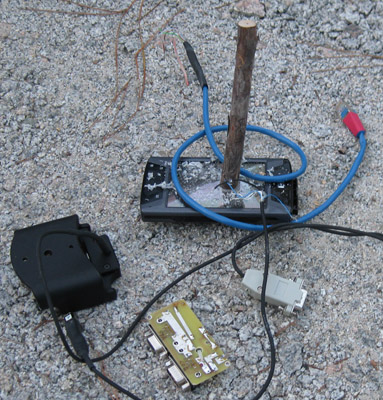 OK,
I need you to help me come up with a good, funny or
ironic caption to go along with this photo.
E-mail me your favorite caption for the photo and
I'll add it to this newsletter along with your name
and location (city, state or province, country), and
perhaps include it in a future newsletter too.
The best one (I decide) wins a free copy of "Sailplane
Grand Prix in the Andes" on Blu-ray or
DVD. The contest ends on December 1st. OK,
I need you to help me come up with a good, funny or
ironic caption to go along with this photo.
E-mail me your favorite caption for the photo and
I'll add it to this newsletter along with your name
and location (city, state or province, country), and
perhaps include it in a future newsletter too.
The best one (I decide) wins a free copy of "Sailplane
Grand Prix in the Andes" on Blu-ray or
DVD. The contest ends on December 1st.
The photo was
taken and sent to me by Jay Campbell (56). In
fact, Jay handled the concept, execution,
photography and even sacrificed his own PDA for the
photo. Yes, that is a wooden stake, driven
through the heart of the PDA. It makes one
wonder just what lead to the untimely end for this
particular iPAQ h4700. Was it the lack of
sunlight visibility, or the tendency for that model
to overheat and shutdown...? Or was it soaring
software that re-booted every 5 minutes while in
flight (only while in flight)?
Certainly,
many soaring pilots have had tough days with PDAs.
PDAs require a certain amount of care and
maintenance to work well in a glider. Yet many
glider pilots do use PDAs in the cockpit. I do
often. They aren't perfect, but they are a
good compromise of price and performance. When
taken care of and prepared well, they can be
extremely reliable.
My quick
thoughts...
- "What
do you mean "battery low, shutting down"? - I'm
about to round the freakin' turnpoint!!!"
- "So,
you won't cooperate, eh... We will only
take so much from you... My patience has
limits."
- "As
soon as we land, I'm tellin' you.... I'm
going to KILL this damn thing..."
- "What?
"Overheating, Shutting down"?!!! The task
is about to open...!!!"
- "You
wanna know what I think of PDAs? Here, hand me
that wooden tent stake and a 10 pound sledge
hammer and I'll show you!"
- "Here
lies the PDA of Fred, it failed in flight, and
now it's dead."
Captions
sent in by readers:
- "Paul, Please accept my
order for one ClearNav." - Duane Eisenbiess
|
|
Condor News |
 I
recently had the good fortune to fly with a group of
Condor racing pilots on a Tuesday evening. It
was an online race. I was sitting in my office
in Minnesota while the other pilots were at their
home computers. Sean Fiddler organized an
online race in the Mifflin, PA Condor online world.
It was a lot of fun ridge running in a Discus 2 on a
cold fall evening. I had a blast! I got
a little bit of a late start - which was good
because then I could see everyone out in front of me
- leading the way. I was doing fine until I
was distracted by real life (RL). My wife
asked me to please make some copies for her - so I
asked my son Adam to please take the joystick for a
few minutes. Adam is pretty good at flying
flight simulators and at flying a full size glider
with me, but he had never flown a water ballast
laden hot ship before... Unfortunately he got
a little slow and it went into a spin. I
wasn't able to recover before impacting the ridge.
The funny part is that I was embarrassed, so I sent
a text message out to the other competitors (just
hit Enter and start typing) and tried to explain the
situation "My wife asked me to make a copy for her
and then my son Adam took over and accidentally got
into a spin...". The response I got back was
something along the lines of "That old excuse... If
I had a nickel for every time I heard that one...".
The good news is that the race was setup with very
non-restrictive rules, so the glider automatically
recovered and I was able to continue the race.
I didn't win, but I learned a lot and had a ball. I
recently had the good fortune to fly with a group of
Condor racing pilots on a Tuesday evening. It
was an online race. I was sitting in my office
in Minnesota while the other pilots were at their
home computers. Sean Fiddler organized an
online race in the Mifflin, PA Condor online world.
It was a lot of fun ridge running in a Discus 2 on a
cold fall evening. I had a blast! I got
a little bit of a late start - which was good
because then I could see everyone out in front of me
- leading the way. I was doing fine until I
was distracted by real life (RL). My wife
asked me to please make some copies for her - so I
asked my son Adam to please take the joystick for a
few minutes. Adam is pretty good at flying
flight simulators and at flying a full size glider
with me, but he had never flown a water ballast
laden hot ship before... Unfortunately he got
a little slow and it went into a spin. I
wasn't able to recover before impacting the ridge.
The funny part is that I was embarrassed, so I sent
a text message out to the other competitors (just
hit Enter and start typing) and tried to explain the
situation "My wife asked me to make a copy for her
and then my son Adam took over and accidentally got
into a spin...". The response I got back was
something along the lines of "That old excuse... If
I had a nickel for every time I heard that one...".
The good news is that the race was setup with very
non-restrictive rules, so the glider automatically
recovered and I was able to continue the race.
I didn't win, but I learned a lot and had a ball.
Condor
Gaining Popularity
Condor has been selling extremely well this year.
Many pilots are using is for racing tasks, flight
instruction, spring refresher flights, etc. It
is a great program.
Details
New
Condor Sceneries
Below is a list of a few of the many new Condor
sceneries that are available at:
http://www.condor-club.eu/sceneries/0/
-
Uvalde, Texas, USA - Site of the 2012 World
Soaring Championships
- Area
51 - Small photorealistic (161x161 km)
scenery covering the Tonopah Test Range, Nevada
Test Site, Nellis Gunnery and Bombing Range and
Area 51 in the Nevada desert.
In Real, this is restricted airspace and area.
- Hood River HD -
A small High-resolution, photoreal landscape of
the Columbia River Gorge area from the PacificNW
2.0 Landscape.
- Colorado 1.2 is
a Terragen/photoreal landscape of Colorado's
Front Range. This is were the Rockies meet the
prairie lands. The mountains are Terragen based
and the flat land is based off of NASA satellite
images.
- Logan 1.01 -
Photo-realistic scenery in standard resolution.
Logan is the site of the 2011 US 15 meter
Nationals (July 19-28 2011) and it covers
northern Utah, southeast Idaho and southwest
Wyoming including all the active gliding sites
frequented by NUTSO (about 95% of the Logan Utah
contest area).
Includes the Great Salt Desert, Great Salt Lake,
Wasatch Front, Ouinta Mtns, Salt River Range,
Wind River Range and Grand Tetons.
-
Nevada 1.0 - Nevada is a Terragen/photoreal
landscape of the high plains desert just north
of Sunny Las Vegas. Some of the most remote
countryside in the USA.
- San Diego 1.1 -
South West California / San Diego scenery
(freeware version) with low-res textures but
fully compatible (for multiplayer flights) with
the payware (and hi-res) version available from
SimMarket.
- New Mexico
-
Central Florida
-
Grand Teton National Park - Grand Teton
National Park is a United States National Park
located in northwestern Wyoming, south of
Yellowstone National Park
- Virgin Islands
Condor
Corner Articles
You may have seen the many excellent "Condor Corner"
articles by Frank Paynter and Scott Manley in
Soaring magazine. Did you know they are all
available on my Condor web page here:
http://www.cumulus-soaring.com/condor.htm#Documents
|
|
Cross
Country Soaring with Condor
|

The goal of the book is to teach sailplane pilots how to use Condor to
become better (faster, safer) cross-country soaring pilots. If you
are not a pilot of full-size gliders, you can use the book to
improve your skills and speeds when competing with other Condor pilots
online. Frank is a very experienced cross-country soaring pilot.
In recent years he has been flying in many soaring contests each year -
and doing well in them. During the off season (when his glider is
put away for the winter) he flies Condor - a lot! He spends many
dozens of hours racing in Condor - with the goal of gaining experience
that he can apply in the cockpit - to help him win races. It seems
to be working for him. He's good, and he does a very good job of
passing on many speed and safety related tips in a clear and concise
way. The
Table of
Contents
gives you a good idea of what to expect from the book - as does the
Introduction. The book starts with the basics of how to use
Condor, and moves on to advanced cross-country soaring tips and detailed
instructions for getting into online racing with glider pilots around
the world with Condor.
Anyone interested in using Condor to improve their cross-country soaring
or sailplane racing skills should get this book.
Details
|
|
Condor Cross-Country Training Available - by
Frank Paynter |
For the second
year, I (Frank Paynter) am offering one-on-one
cross-country mentoring sessions using the Condor
soaring simulator. As instructor I host a Condor
server on my PC here in Columbus, Ohio, and the
student joins it from wherever they are - all they
need is a good internet connection (i..e DSL or
better). A regular telephone connection is used as
an 'open mike' intercom for conversation.
I started this on an experimental basis last year,
and it seemed to work very well. Comments from
students/mentees was uniformly positive. This year I
am charging $25/hour with all proceeds going to the
U.S. Soaring Team fund. I have no interest in making
money at this, but I have found that charging a
reasonable fee tends to make everything work a bit
better, and besides, the U.S Soaring Team needs all
the help it can get ;-).
I will host 3hr blocks on Wednesday and Thursday
evenings from 7-10pm U.S. East coast time, starting
on Wednesday September 28, 2011 and running through
Thursday February 23, 2012. You can sign up for a
block by going to a free calendar/appointment
package I have set up at
http://condorxc.calendarspots.com.
If you have questions or would like additional
information, please contact me at
paynterf[at]gmail.com. Experienced cross-country
racers with an interest in mentoring less
experienced pilots are encouraged to contact me - I
will be happy to help you get up to speed in Condor
and start your own Condor cross-country racing
'camp'. Flying in Condor over the winter months
certainly beats looking out the window and waiting
for spring!
Frank Paynter
|
|
Region
6 Condor Contest |
 Sean
Fidler and Frank Paynter are organizing a live (not
online) Condor soaring contest get-together in
January - probably somewhere in Michigan.
Great weather and good fun are guaranteed!
What a fun idea. Sean
Fidler and Frank Paynter are organizing a live (not
online) Condor soaring contest get-together in
January - probably somewhere in Michigan.
Great weather and good fun are guaranteed!
What a fun idea.
The text below
is from the web site for the event.
The awesome
photo at right is of John Sullivan in his Ventus 2
(UFO). It was taken by Aaron Kiley. He
also took the photo below. Very nice! Be
sure to click on them to view the larger versions.
 How
would you like to get together with other Soaring
and Condor enthusiasts at a central location and
duke it out over a weekend to find out who is the
best over a 4 series, with a Tee-shirt for all
attendees and awards for the top three places? If
your answer is YES, here is your chance! How
would you like to get together with other Soaring
and Condor enthusiasts at a central location and
duke it out over a weekend to find out who is the
best over a 4 series, with a Tee-shirt for all
attendees and awards for the top three places? If
your answer is YES, here is your chance!
The first ever live Condor Contest will be organized
as much like a real-life regional SSA sanctioned
contest as possible. Weather will be realistic and
non-trivial. Tasks will be 2-3 hours in length and
will feature typical TAT/AAT & MAT racing tasks set
in the most beautiful, fun and challenging locations
in the world (all within the same weekend!). Rules
will be U.S. Contest rules.
Schedule:
Friday Jan 13 - Practice evening
Saturday Jan 14 - Contest Day 1 & 2 - Morning and
Afternoon tasks.
Sunday Jan 15 - Contest Day 3 & 4
Weather: There is never bad weather in Condor! We
guarantee outstanding soaring weather!!!
Awards: Trophies will be awarded to the top three
finishers immediately following Contest Day 4!
Entry Fee: $25 (includes a T-shirt). Payable at the
door.
Details:
https://sites.google.com/site/region6condorcontest/home
|
|
George Popa
Sculptures |
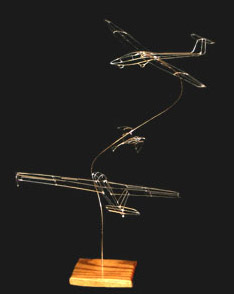 Cam
Martin sent me a link to George Popa's wonderful
sculptures. He offers a wide variety of
sculptures - including sailplanes and airplanes.
You can see some of them below. They include
Schweizer 1-26, Schleicher ASK-21, Minimoa, and ASW
20 sculptures. Cam
Martin sent me a link to George Popa's wonderful
sculptures. He offers a wide variety of
sculptures - including sailplanes and airplanes.
You can see some of them below. They include
Schweizer 1-26, Schleicher ASK-21, Minimoa, and ASW
20 sculptures.




http://www.georgepopasculptures.com
http://www.georgepopasculptures.com/works.html#Aircraft
|
|
Becker
AR6201
|
 October 11,
2011 - Becker Avionics Announces TSO certification
of AR6201 VHF-AM Transceiver October 11,
2011 - Becker Avionics Announces TSO certification
of AR6201 VHF-AM Transceiver
Press Release
This
radio is destined to be extremely popular for use in
sailplanes. The small size, low current drain,
excellent quality, low voltage operation, and large,
clear graphical display make it ideal. You can find
lower cost, lower quality radios, but you will
probably end up paying more for them in the long run
with repairs and down-time. Wouldn't you rather have
a radio that just always works! This radio is worth
the investment.
 The hottest
feature of this radio is its "Scan Mode". In scan
mode (also called dual watch function) the device
can monitor two frequencies (active and preset) at
the same time. An arrow points to the frequency
(active or preset) from which the audio is derived.
The active frequency has priority. If a signal is
received on both frequencies at the same time, you
will hear the transmission being received on the
active frequency - and the preset frequency is
inverted and blinking - to indicate that you are
missing the transmission on the preset frequency. The hottest
feature of this radio is its "Scan Mode". In scan
mode (also called dual watch function) the device
can monitor two frequencies (active and preset) at
the same time. An arrow points to the frequency
(active or preset) from which the audio is derived.
The active frequency has priority. If a signal is
received on both frequencies at the same time, you
will hear the transmission being received on the
active frequency - and the preset frequency is
inverted and blinking - to indicate that you are
missing the transmission on the preset frequency.
There is
other good news. Users of Becker AR4201 radios
can easily switch to the AR6201 - the wiring harness
connections are compatible. You can therefore
install the AR6201 using the same wiring harness as
used by the AR4201.
This new
radio is already very popular. I received 3 of
them today and they have all been sold! I
expect more to arrive in a week or 2.
AR6201
Brochure
Details
|
|
Soaring Flight
of the Month
|

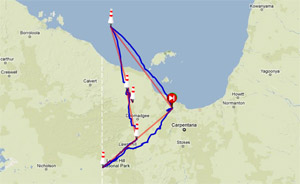
On September 24, 2011 Geoff Pratt made a very
interesting flight in his PIK 20 E auxiliary powered
sailplane. He started in Burketown, Australia.
His note on the OLC web page states: "Morning glory
flight NW then SE to Adels Grove continue with
thermal flight back to Burketown." That may be
a bit understated. He flew 941.5 km (OLC
distance) and much of the flight was out over open
water. It must take a brave pilot to fly out
over open water in a sailplane.
Congratulations Geoff! If you read this,
please send a detailed report for the next
newsletter.
http://www.onlinecontest.org/olc-2.0/gliding/flightinfo.html?dsId=2134907
I'm sure
most of you know what a Morning Glory looks like,
but I thought I'd include the images below to
clarify - just in case. They can stretch for
hundreds of miles. The photos below are not from
the same date or location - but I believe they were taken in the same region.


Please send me a short
write-up of your best recent soaring flight - and I
will try to include it here. Please include a
link to the flight on the OLC and a few
photos.
|
|
SimplyKool Metallic Canopy Covers |
 How
many times has this happened to you? You get out to
the flight line and wait a while for your turn to
fly. While waiting, you keep your sailplane's canopy
closed - because you don't want your expensive
canopy damaged by being slammed closed by the wind.
Meanwhile, the sun is beating down into your glider
- heating up the inside, but with the canopy closed
there is no air circulation - so everything inside
the glider gets hot - very hot - probably over 140°
F hot!!! (OK, I'm just guessing at how hot - but you
know it gets hot.) Your expensive soaring
instruments are baking in the sun. The metal buckles
on your seat belts and parachute harness are too hot
to touch. The paint on the instrument panel cover
gets discolored over time. Your PDA gets so hot it
shuts down. Your glider battery doesn't like the
extreme heat - and doesn't last as long as it should
because of it. After you get into the glider, you
feel like you have entered some medieval torture
chamber. How
many times has this happened to you? You get out to
the flight line and wait a while for your turn to
fly. While waiting, you keep your sailplane's canopy
closed - because you don't want your expensive
canopy damaged by being slammed closed by the wind.
Meanwhile, the sun is beating down into your glider
- heating up the inside, but with the canopy closed
there is no air circulation - so everything inside
the glider gets hot - very hot - probably over 140°
F hot!!! (OK, I'm just guessing at how hot - but you
know it gets hot.) Your expensive soaring
instruments are baking in the sun. The metal buckles
on your seat belts and parachute harness are too hot
to touch. The paint on the instrument panel cover
gets discolored over time. Your PDA gets so hot it
shuts down. Your glider battery doesn't like the
extreme heat - and doesn't last as long as it should
because of it. After you get into the glider, you
feel like you have entered some medieval torture
chamber.
Problem Solved!
 SimplyKool™
Metallic Canopy Covers are designed solve the
cockpit heating problem. They are made of shiny
metallic stretchy fabric that reflects the majority
of the sun's energy away from your cockpit - and
they fit your glider's canopy like a glove. They are
elegant in their simplicity, and lightweight and
easy-to-use. Just slip it onto you canopy after you
rig the glider and it will keep the cockpit cool
until you remove it just before takeoff. You can
even leave it on while you get into the cockpit to
keep the sun off until immediately before takeoff.
It compacts down into a very small space - so you
can take it with you while you fly. After landing
you can put it back on in a few seconds to keep
things in the cockpit cool while you download your
flight log and tidy up the cockpit. SimplyKool™
Metallic Canopy Covers are designed solve the
cockpit heating problem. They are made of shiny
metallic stretchy fabric that reflects the majority
of the sun's energy away from your cockpit - and
they fit your glider's canopy like a glove. They are
elegant in their simplicity, and lightweight and
easy-to-use. Just slip it onto you canopy after you
rig the glider and it will keep the cockpit cool
until you remove it just before takeoff. You can
even leave it on while you get into the cockpit to
keep the sun off until immediately before takeoff.
It compacts down into a very small space - so you
can take it with you while you fly. After landing
you can put it back on in a few seconds to keep
things in the cockpit cool while you download your
flight log and tidy up the cockpit.
Details
|
Locomotive to Aeromotive - Octave Chanute and the
Transportation Revolution
- by Simine Short |
 Few
people (even well-read glider pilots) understand
just how much Octave Chanute contributed to the
development of aviation in the late 1800's and early
1900's. Did you know that hundreds of gliding
flights were safely performed over the Indiana dunes
near Lake Michigan in the years around 1896 in
gliders designed by Octave Chanute? Did you know
that he acted as a mentor to the Wright brothers and
witnessed some of their early flights? At the 1904
World's Fair in St. Louis, William Avery performed
glider flying exhibitions in a glider designed by
Chanute and using an electric winch that was also
designed by Chanute. Octave also acted as a
clearinghouse of aviation information - meticulously
collecting every document he could find on the
subject and sharing them along with friendly letters
of support to aviation pioneers around the world. Few
people (even well-read glider pilots) understand
just how much Octave Chanute contributed to the
development of aviation in the late 1800's and early
1900's. Did you know that hundreds of gliding
flights were safely performed over the Indiana dunes
near Lake Michigan in the years around 1896 in
gliders designed by Octave Chanute? Did you know
that he acted as a mentor to the Wright brothers and
witnessed some of their early flights? At the 1904
World's Fair in St. Louis, William Avery performed
glider flying exhibitions in a glider designed by
Chanute and using an electric winch that was also
designed by Chanute. Octave also acted as a
clearinghouse of aviation information - meticulously
collecting every document he could find on the
subject and sharing them along with friendly letters
of support to aviation pioneers around the world.
 Simine
Short has a passion for aviation history and has
thoroughly researched and documented the life and
work of Octave Chanute in this book. She also
included many wonderful photographs and diagrams.
Well done Simine!!! Simine
Short has a passion for aviation history and has
thoroughly researched and documented the life and
work of Octave Chanute in this book. She also
included many wonderful photographs and diagrams.
Well done Simine!!!
As a mechanical
engineer, MBA graduate, and glider pilot, I found
the entire book very interesting. It is an amazing
trip back in time - to the time of steam ships and
steam locomotives. Octave Chanute was an amazing
man, engineer, and pioneer. The first half of the
book covers his early life and his work for
railroads - helping them extend across the central
U.S. He was a respected railroad bridge designer
(first in
 wood
- later in steel) and was responsible for innovated
work in railroad tie preservation (life extension
through the injection of preserving chemicals). Any
glider pilot will find his life and accomplishments
fascinating. The life history and engineering parts
of the beginning of the book are a welcome look into
what makes-up the character and experiences of the
man - helping to explain his later aviation
achievements. Glider pilots will find the last 1/3
of the book the most interesting - which details his
aviation accomplishments. wood
- later in steel) and was responsible for innovated
work in railroad tie preservation (life extension
through the injection of preserving chemicals). Any
glider pilot will find his life and accomplishments
fascinating. The life history and engineering parts
of the beginning of the book are a welcome look into
what makes-up the character and experiences of the
man - helping to explain his later aviation
achievements. Glider pilots will find the last 1/3
of the book the most interesting - which details his
aviation accomplishments.
Cool quote in the front of the book
"From the locomotive to the
aeromotive," shouted the noisiest of all, who had turned on the
trumpet of publicity to awaken the Old and New Worlds. ... A
flying machine must be constructed to take advantage of the natural
laws, but it is not necessary to copy Nature completely.
Locomotives are not copied from the hare, nor are ships copied from
the fish. To the first we have put wheels, which are not legs;
to the second we have put screws, which are not fins.
Besides, what is this mechanical movement in the flight of birds,
whose action is so complex?
- Jules Verne, The Clipper of the
Clouds (1887)
Details
|
|
Digital Sectional Chart Downloads Threatened |
The note below
was posted on the rec.aviation.soaring newsgroup on
Friday, November 18th by Lynn Alley. Lynn
provides a fantastic resource for glider pilots at
http://www.soaringdata.info/
and is obviously knowledgeable on the subject.
Please sign the online petition. It is pretty
easy to do using the
www.whitehouse.gov
web site. You'll need to create a user
account, but it is extremely easy to do. The
link to use is at the bottom of the note below. -
Paul Remde
As most of
you are probably aware, digital versions of
sectional charts are currently available for free
download from the FAA. However, Aeronav, the
branch of the FAA responsible for digital chart
publication, has apparently decided to withdraw them
from free publication. Here is a quote from a letter
sent to some subscribers (by the way, I'm not one of
them; I have seen excerpts from the letter posted on
the Internet):
"FAA's Aeronautical Navigation (AeroNav) Products
has reengineered its business processes. One of the
changes that we have identified is the need to have
clear agreements with Authorized Agents on the
distribution and packaging of our digital products.
As safety is the
key mission of the FAA, it is imperative that the
integrity of our navigation products is maintained
in digital forms just as it is in paper forms. April
5, 2012 will be the last edition of our products
that will be distributed to individuals or
businesses without a license agreement."
This change is likely to have an impact on the
Soaring community. As things stand now, the vendors
and developers of Soaring software such as SeeYou,
Strepla, and GlidePlan have unfettered access to
these sectional charts. They can and do provide
updated versions as free
downloads. The same applies to the Open Source
community. The concern is that the proposed license
agreement would almost certainly restrict free
redistribution. There are rumors that the FAA will
disallow removal of the legends and edge material in
redistributed versions -- that would make seamless
stitching of charts impossible. They may also
prohibit the reprojection necessary to display the
charts properly in a rectangular grid, such as is
used in virtually all glide computers and flight
planning software. There are likely to be
substantial costs involved in becoming a licensed
redistributor. Faced with these restrictions,
the developers of soaring software are
likely to simply withdraw support for US sectionals,
and current digital representations of them in
soaring products will become a thing of the past.
It is interesting to note that Aeronav maintains
that safety is the key reason driving this change. I
feel some skepticism about this. I have never heard
of an accident or incident that was caused by lack
of "integrity" of a redistributed digitial product.
It seems more likely that the change is motivated by
money, as there is an is an ominous reference to
"pricing structures" in the letter sent to
subscribers.
Here is a link to an EAA article about the change:
http://www.eaa.org/news/2011/2011-11-16_charts.asp
There is an online digital petition in opposition to
the change at
this link:
https://wwws.whitehouse.gov/petitions/!/petition/ask-faa-reversal-charge-government-approach-data-downloads-and-not-allowing-individuals-access-them/Hg1nqTJy?utm_source=wh.gov&utm_medium=shorturl&utm_campaign=shorturl
Lynn Alley
"2KA"
PS. The airspace and airport information on my
website comes from a
different part of the FAA, and is not threatened at
this time. One
worries about the future though, if this policy
should become the
established norm.
|
|
Cross-Country
Soaring - Back in Print |
 Helmut
Reichmann's extremely popular book "Cross-Country
Soaring" is finally back in print. It had been
out of print for about a year. It is "flying"
off the inventory shelves again. It remains
one of my favorite soaring books. Helmut
Reichmann's extremely popular book "Cross-Country
Soaring" is finally back in print. It had been
out of print for about a year. It is "flying"
off the inventory shelves again. It remains
one of my favorite soaring books.












Details
|
|
Soaring Safety Sites |
|
Below are links
to 2 awesome web
sites dedicated to soaring safety. They
feature great training videos and safety tips.

British Gliding Association - Safe Winch Launching
http://www.gliding.co.uk/bgainfo/safety/safewinchlaunching.htm
Soaring
Safety Foundation - Accident Producing Video Clips
http://www.soaringsafety.org/school/badvideo.html
|
|
Instrument Panel Photo of the Month |
 I sell a lot of
soaring instruments, but I rarely get to see them
installed and ready to fly. I really enjoy
receiving photos showing how the items purchased
from me have been put to good use. It makes my
job more interesting and fun! Feel free to send me a
photo of your glider panel if you especially proud
of how it looks. I sell a lot of
soaring instruments, but I rarely get to see them
installed and ready to fly. I really enjoy
receiving photos showing how the items purchased
from me have been put to good use. It makes my
job more interesting and fun! Feel free to send me a
photo of your glider panel if you especially proud
of how it looks.
The
instrument panel above includes a few items
purchased from me by Avron Tal of Israel. He
purchased the Naviter Oudie, TruTrak Pictorial Turn
& Bank, Borgelt B500 and other instruments and books
and videos from me over the last 5 years. The
video in the link below was taken by his friend in a
PIK 20E they own together. Sitting at my desk
here in Minnesota, it is fun to see the instruments
from here flying over the Dead Sea. It is also
neat that we glider pilots from different parts of
the world have much in common.
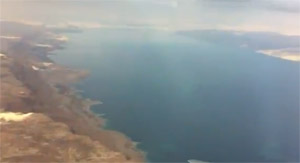
Soaring Near the Dead Sea
Glider pilot from Israel in his Pik20E. The flight
is above the Dead Sea along the Jordanian boarder.
Landing along the lake is Masada air strip at -400m
(400 meters below sea level).
http://www.youtube.com/watch?v=nzNlXktLfpo
|
|
Bumper
Quiet Vent and Yaw String |
John Morgan
("Bumper") makes some very nice, simple, inexpensive
products for sailplanes. For fun he flies a
Schleicher ASH 26 and an Aviat Husky A1-B. His
Quiet Vent and Yaw String products have been
extremely popular. I've shipped hundreds
of them since I started selling them earlier this
year.
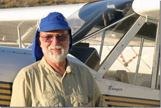


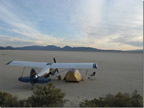
Quiet Vent
The Quiet Vent is a very simple device which reduces
noise from a Mecaplex flip-out window vent by 10 dba
(as measured in ASH26E at 60 knots). Price: $9
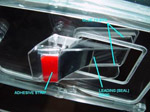
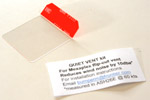

Note: The red area that is visible in the photos
above is the plastic adhesive backing which is
removed when the item is installed. The Quiet Vent
is clear.
MK IV Yaw
String
The MKIV Yaw String is an elegant and useful
addition to any sailplane. It is available in red
and blue colors and either wool or synthetic
material. Price: $15

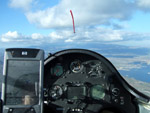

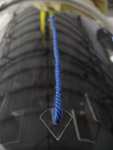 \ \
Features of the MKIV "high tech" yaw
string:
- A clear turbulator base raises the
yarn 0.038" above the canopy to reduce static cling or scratched
canopy plastic.
- Easy to remove for replacement
leaving no tape residue.
- Looks much nicer than tape and yarn.
- Includes optional (meaning you can
opt to install it or not install it) index dot.
- Available in either original natural
wool or synthetic yarn in red and royal blue.
Details
|
|
Mountain High Oxygen builds the 3000th Pulse-Demand
Oxygen unit |
 Building
on its leadership in general aviation oxygen
systems, Mountain High’s aviation oxygen technology
for general aviation and rotorcraft has built number
3000 of the two-person “MH EDS O2D2 Pulse-Demand *FADOC™
Oxygen Delivery Unit”. The MH EDS O2D2, designed and
manufactured in Oregon, is the only single unit,
portable, two-place, digital Pulse-Demand oxygen
system available and is used through-out world by
experienced pilots, both civilian and military. Building
on its leadership in general aviation oxygen
systems, Mountain High’s aviation oxygen technology
for general aviation and rotorcraft has built number
3000 of the two-person “MH EDS O2D2 Pulse-Demand *FADOC™
Oxygen Delivery Unit”. The MH EDS O2D2, designed and
manufactured in Oregon, is the only single unit,
portable, two-place, digital Pulse-Demand oxygen
system available and is used through-out world by
experienced pilots, both civilian and military.
* FADOC™ = Full
Authority Digital Oxygen Control
The MH O2D2,
with the patented digital electronic “Pulse-Demand”
*FADOC™ oxygen delivery system was tested by CAMI
(FAA Civil Aerospace Medical Institute). The O2D2
enables the pilot and passengers to fly at pressure
altitudes up to 25,000 feet with absolute oxygen
safety and comfort. The O2D2 digital pulse-demand
system reduces oxygen consumption dramatically.
Different from the “standard” constant flow systems,
the O2D2 pulse demand system wastes no oxygen during
the breathing cycle. The average user will enjoy a
conservative consumption drop of four (4) times or
more compared to the manual constant flow systems.
The system operates, with one or two people, for up
to 50 + hours on three AA alkaline batteries.
Easy to use,
the two-person O2D2 reduces oxygen system workload
to almost nil. There are no oxygen flow indicators
to watch or manually operated constant flow valves
to adjust due to altitude changes. The O2D2, through
the various modes, automatically delivers the
required oxygen pulses for changing altitudes… for
both the pilot and passenger or with an additional
O2D2, two additional passengers. MH EDS O2D2 is a
fully functional portable system. The portable
system consists of an aluminum oxygen cylinder
(buyer has a choice of sizes), a cylinder carry
case, seat back holding straps, primary reducing
regulator, low pressure service line, all connection
fittings, the MH EDS O2D2 FADOC™ unit, breathing
cannulas, face masks, batteries and a tote
bag…everything needed for a complete supplementary
oxygen system, including a limited warranty.
A variety of
options are available to meet specific pilot needs,
including lightweight composite cylinders, four
place regulators, adapters, Oxy-Arm boom cannulas
and comfortable silicon facemasks with built in
noise cancelling ClearSpeak™microphones.
Details
Congratulations to one at Mountain High on this
major milestone! - Paul Remde
|
|
Lessons from the Back Seat Behind a Champion -
by Ron Clarke |
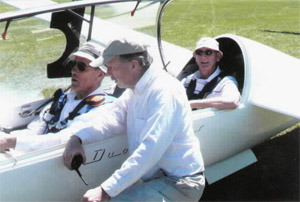 The
notes below were provided by Ron Clarke after flying
for 2 days with Karl Striedieck in the "Seniors"
soaring contest in Florida. Ron is a very
experienced cross-country and racing pilot (he's
good, and fast) - so it is very interesting to read
through his notes from those 2 days. Thanks
for sending this to me Ron! The
notes below were provided by Ron Clarke after flying
for 2 days with Karl Striedieck in the "Seniors"
soaring contest in Florida. Ron is a very
experienced cross-country and racing pilot (he's
good, and fast) - so it is very interesting to read
through his notes from those 2 days. Thanks
for sending this to me Ron!
The
photo at right shows Karl in the front seat, Ron in
the back seat and John Good chatting with Karl.
Lesson One
It’s early March and the sun is shining down in
Florida. A couple of practice days lie ahead
of the start to the 2011 soaring competition season.
I’m lucky, very lucky as I’ve managed to arrange a
ride in the back seat of a Duo Discus and I plan to
soak up as much as is possible about how to do it
well. The pilot in command is a legend in our
lifetimes.
I wasn’t sure what to expect as I’d heard many
differing opinions about such experiences. What
follows is mine:
Attitude is what counts I know, and as if to
emphasize the point we’re the third to take off on
the first of two practice days - Blue skies and
relatively early - time in the air under whatever
conditions offered is seen as acceptable, after all
these may be the contest type conditions!
Amazing to me but within the first seconds of flight
behind the tow plane the pilot verbalizes potential
actions if needed " Straight ahead, straight ahead"
he says until it’s "field to the left" as we pass
100ft agl. Something ingrained maybe 40 years
ago but still sensible discipline.
In the first strong lift at reasonable height we
release from our tow and careful thermalling allows
a climb out from 1600 agl. - no need to go higher if
you’re confident that the lift is good.
Did I say
careful thermalling? Maybe more correctly
skillful thermalling - very close speed control and
very accurate and tight turns, with precise
corrections to ensure we maximize use of the thermal
cores. I’ve always believed in "tighter rather
than wider" but my skills at the stick showed less
than acceptable performance when given a chance to
fly the Duo!
With lift in
the 2.5 knot range and thermals in the blue to only
3500agl. conditions were challenging, but we flew 80
miles o/r - never in serious trouble.
Always
looking for birds, of which there are more than
average numbers in Florida skies and taking note of
ground features that might trigger lift we progress
- basic stuff one learns about thermal sources.
But one more thing - how often do you the pilot look
down carefully when in a good thermal and verbalize
the likely source of the lift you find yourself in?
Parking lots, an orange grove, the brown ground.
Always add to your data base of knowledge about
thermal sources - a good reminder. Never
faster than necessary and usually pretty straight on
course (less deviation than the 30 degrees I
accept). Feeling the air as we go would be my
description - turning into wind to take advantage of
any streets of lift and then getting back to course
when lift diminishes . Long glides rather than
stopping for lift unless it really feels like
average or better. Oh, did I mention the downwind
side of the many lakes in this area? - Not a good
idea when the working band extends down from 3500 to
1500agl. Many times we looked for landing
options when down to 1500agl, using both the
computer and discussing field options in sight.
The cockpit
was well sealed, quiet and we flew with the window
vent closed, opening it only to freshen the air when
thermalling - sometimes with a hand out to scoop in
more! Radio talk was strictly minimum.
Lesson Two
Did I mention the importance of Attitude in my first
write up? Today was the "official" practice
day so guess what. With near to 55 gliders
wanting to fly our pilot decides to take the
positive approach, set the pace and take off first.
Into the blue once more, but as we need to wait
until all are airborne for a start we do some
considerable touring up the first leg, gaining
reasonable info re the thermal strengths and
heights.
The Start was good - right at maximum thermal height
on the edge of the circle and we’re number two to
start - Dick Butler was first but I don’t believe we
ever saw him. A good long first glide out
despite the relatively low start height and would
you believe it - no one in sight following us when
we stop for the first good thermal. Such good
fortune must be taken advantage of so we keep going
with some reasonable ability to cruise in blue lift
streets - Never fast though.
Today was
very similar to the first day with respect to
thermal tops - maybe close to 3600msl, and our pilot
whistled more. He told me "I whistle when
happy (high) and when nervous (low)". The
further north we flew the tougher it got so we
whistled and turned back south. Then some real
lessons - the first save was over a landable but not
desirable field - pasture land with poor access. We
widened the search area and with the help of a
couple of vultures hooked a thermal from around
900ft agl.
By dialing
in computer info on airports en route we tip-toed
back south much as I would have done so under such
marginal conditions - it worked well and we were
mostly in range of airports. Back past
Seminole Gliderport and on south - never high - the
best heights had been an hour ago. We clipped
the second turn circle and headed back north.
We tried the same area where a reasonable thermal
had helped us earlier but no dice - "Lift is where
you find it" - no guarantees. Now for a real
lesson - we’re headed home but out of range of an
airfield with just some cattle pastures reachable.
Cruising north at 800agl we find a weak thermal and
climb to 1200agl so now the first order is to
identify landable fields. There are some but many
with cattle in them - not good.
There is a
fire ahead - but if it doesn’t work - what then?
We agree on a field near the fire, cattle or no
cattle. Lower and lower we get but closer also
to the fire. It will be one pass through the
smoke and if it doesn’t work downwind, base and into
the field. Now we’re in the smoke at 500agl
but no lift. We exit the smoke onto a downwind
for the pasture and peep, peep, the vario speaks.
We’re still in position to land in the pasture but
less than 500agl. One more turn and the peep,
peep, peep continues with no loss in altitude.
"What now?"
our pilot says. My confidence in his superb
thermalling skills causes me to say "let’s stay with
it" and he does - climbing away from around 400agl
to sufficient height to make the third turn point
circle and then turn for home. Interestingly
the lift was not in that smoke but next to
it.
Final glide
was decided upon based on a safety margin of 500feet
above field height at a MacCready setting of 4
knots. This is the only time in the 7 hours in
that back seat that we flew above 90 knots as the
excess height is burned off within the last 3 miles
to the landing field.
The landing pattern is at a crisp speed and a good
margin kept with plenty of airbrake although not
during any turns. Landings were executed with
precision, gentle considering a goodly amount of
airbrake on final, but with a graceful round out.
What a unique experience. We were on course
for just under 3 hours, covered around 160 miles but
only once above 3000agl - most of the time between
1800 and 2500 ft above the ground. Our average
climb rate was 1.9 knots. In all a most
enjoyable flight . Confirmation to me that one
of the great beauties of soaring is that one never
stops learning .
Many thanks Kilo Sierra.
Ron Clarke
|
|
Riding On Air - Ridge
Wave and Convergence Lift |
 The
latest addition to Bob Wander's Gliding Mentor
series is Rolf Hertenstein's brand-new opus Riding
on Air: Ridge, Wave, & Convergence Lift. The
latest addition to Bob Wander's Gliding Mentor
series is Rolf Hertenstein's brand-new opus Riding
on Air: Ridge, Wave, & Convergence Lift.
Rolf's
previous book "Thermals"
has been extremely popular.
Overview by Bob Wander
We think the title says it all. As a long-time
airplane pilot and gliding pilot who first learned
to fly in mountainous country, I am amazed and
delighted at all of the things that Rolf explains in
this book that have been a mystery to me for many
years. Most soaring pilots have some appreciation of
ridge, wave and convergence lift; I wish EVERY
soaring pilot had the depth of knowledge and
experience with these types of lift that Rolf has,
and that he reveals in this book. We would all be
the safer for it! Riding On Air contains what you
need to improve your soaring performance in ridge,
wave, and convergence lift. Furthermore, you'll
learn why these types of lift sometimes disappear,
seemingly without warning to the under-prepared
pilot; and that in turn can lead to close scrapes
(at best), or to disaster (at worst).
Another thing that surprised me about this book was
how often convergence lift is present, even when far
away from mountains or oceans or other large-scale
geographic features. I now see convergence events in
the atmosphere almost-daily frequency, because I
have learned what the physics of these convergences
are, and how to recognize them by visible signposts
in the air.
Details
|
|
New
Stuff |
|
Goddard
P-ColibriII-1 Cable
For connecting an LX Navigation Colibri II to a
Goddard PS-5a power converter. DB-9f at PS-5a end
and mini-USB at Colibri II end. The PS-5a provides
5V power for the Colibri II. The cable's DB-9f
connector housing has a built-in RS-232 to TTL data
level converter which allows the Colibri II to
communicate with any PDA.
Details
 Goddard
Cable-Oudie-LNav-0p3 Goddard
Cable-Oudie-LNav-0p3
Cable, 0.3 m (11.8 inches), Naviter Oudie Power/Data
Cable to Cambridge L-NAV
It is possible to setup a Naviter Oudie to output
GPS data and "distance to target" information for
use by a Cambridge L-NAV or S-NAV. This cable has a
male 6-pin RJ connector that plugs into the back of
the L-NAV and a female RJ45 (8-pin) connector for
connection to the Oudie's power/data cable. The
Oudie must be configured to send GPS data out as
described below.
How to send NMEA data using Oudie:
a) Put the latest version of SeeYou Mobile on the
Oudie. It can can downloaded from www.naviter.si in
the Download > Oudie Firmware menu.
b) Start SeeYou Mobile and exit, make sure that
"Save profile" is checked.
c) Connect the Oudie to a PC as described in the
Oudie manual.
d) Using Windows Explorer (My Computer) on the PC,
In the Oudie's memory, open the "Settings" folder
and edit the profile file (DEFAULT.XML if only one
profile is used, otherwise edit the profile you will
be using). It is a text file that can be edited
using Notepad.
e) Find text "COMOUTPARAMS", and change it to "<COMOUTPARAMS>COM4:4800,N,8,1</COMOUTPARAMS>"
and save the changes to the file.
f) Start SeeYou Mobile, set input to "Serial", under
"Port settings" select "COM1"
Details
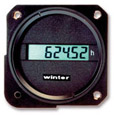
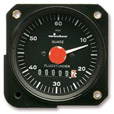
Winter Flight Hours
Counters

Mid-Continent
Electric Analog Clock

Soaring Beyond
the Basics
New 3rd Edition
by Dale Masters
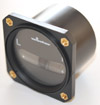
Winter
W-1115
Ball Bank Indicator

Digital
Water Meter Kit (for waterballast)

Revell LS-8t Model
Kit


Cables for Connecting a PDA to a PC for
use with Condor
Keyspan USA-19HS USB Serial Adapter
Condor-PC-5V-DB9f-0.3
|
|
See
ya' at the airport! - 2nd Edition |
 A
new 2nd Edition of "See ya' at the airport!"
by Charlie Spratt is now available. The book
was updated to include a new forward by Karl
Striedieck, and two additional chapters: The Tube
and Sailplane Racing News. Friends and fans of
Charlie will want this new updated version. A
new 2nd Edition of "See ya' at the airport!"
by Charlie Spratt is now available. The book
was updated to include a new forward by Karl
Striedieck, and two additional chapters: The Tube
and Sailplane Racing News. Friends and fans of
Charlie will want this new updated version.
Accolades for See ya' at the Airport!:
Charlie Spratt is the best CD I have ever flown under and that includes
contest in many countries as well as five World Championships.
Fortunately he writes with the same understanding and decisiveness he
brings to contest directing. Soaring would be very much the less without
his inputs, his experience, and his totally distinctive language. It's
all here, told with his inimitable sense of humor. Enjoy!
- George Moffat
The National Soaring Museum exists to record and relate the story of
soaring in America. How better to do that than to publish a book by
Charlie Spratt? Inspired by soaring and an inspirer of those who soar,
Charlie is one of our sport's master story tellers. With this first NSM-published
book, he has set the bar high. Good start, Charlie!
- Peter W. Smith, Director National Soaring Museum
"The Gate" has left his signature on many facets of US soaring
competition, not the least of which has been his unmatched interactions
with all the people who participated in some way. There will never be
another Charlie and having this record of his involvement with the sport
is another of his gifts to us all.
- Karl Striedieck
1st Edition
copies: $5
2nd Edition copies: $20
Details
|
|
Photo
of the Month #1 |

The awesome soaring photo above was a joint effort photograph by
John Sullivan and Aaron Kiley. They are both
professional photographers. The sailplane is
John Sullivan's Ventus 2cxM. Their photo web
sites are below.
John Sullivan -
http://skypics.com/
Aaron Kiley -
http://aaronkileystudio.com/
I'm a hobby
photographer - so while admiring the photo, I
was scratching my head, trying to figure out how
they got this lovely shot. I can tell from the
perspective and wings that a very wide angle lens
was used. But to use a wide angle lens - you
need to be very close to the subject - too close for
air-to-air work with 2 gliders. Fortunately,
they were willing to share how they created the
photo - along with photos of the setup they used.
Thank you Aaron and John for the excellent photo,
and the information on how it was created.
Very interesting!
http://www.youtube.com/watch?v=6tXulGWPIcs



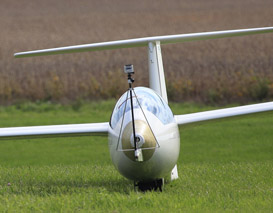
John and
I got together as two photographers both loving
aviation, soaring, and photography/video. We
played around with the best angle for the GoPro.
I figured straight nose would minimize the
effect of the wide lens and would show the whole
world, if not the curved fisheye look. The GoPro
is a really nice quality unit for video, but
it’s still images are a little weak. We did only
one test run with the nose cone not painted yet.
We just turned the GoPro on (on the ground) and
let it run the entire flight. Then one image I
fixed the yellow nose and took the arm out that
held the camera. Pretty easy in Photoshop. But
the image is a capture from the HD video, so the
quality is quite low.
For the future, John is working on a radio
control articulated arm. The GoPro is very
light, but we might consider putting a digital
SLR on next such as the Canon T3i. It’s light
weight for a DSLR, and shoots amazing video and
stills. John has painted and finished the nose
cone so the next images will look much better. I
might be able to take the mount arm out of the
video as well. It’s a little tricky editing and
might not work perfectly, but it will reduce
attention to that area of the image.
On a side note. Building mounts on automobiles
is very popular in editorial and advertising
still photography. If you look at the VW Jetta
on my web site, (coming round the corner with
tree swishing background) this was done by
building a tripod with carbon fiber legs
directly onto the car. Well sort of. Two 14 foot
poles. One attaches under the side door of the
car, the other under the grill. These two poles
meet at the camera end and are held together and
a camera is mounted at that spot. Lastly a wire
is run from the camera end of the mount, over
the top of the car and secured. This wire holds
the rig and camera a few feet off the ground. To
make the image, I set the exposure to about 10
seconds. During the exposure the car is driven
or usually rolled very very slowly so no
bouncing or vibration causes the car to be
unsharp. In Photoshop, I remove the poles and
the wire.
Aaron
Kiley
|
|
Photo
of the Month #2 |
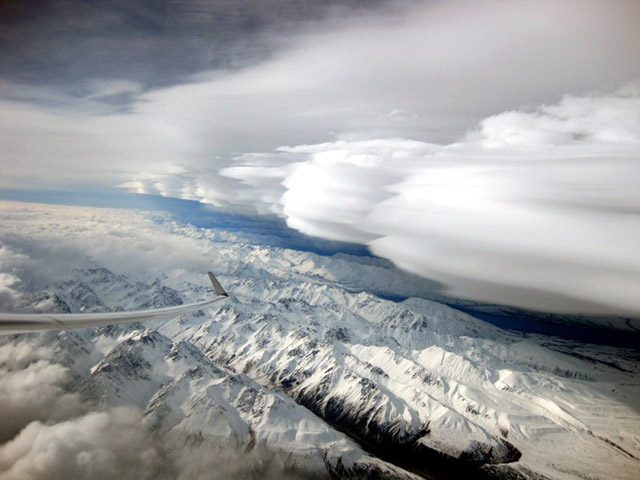
This photo was taken by Terry Delore. It
arrived in my inbox in an indirect way. I
received it from the Vintage Sailplane Association
mailing list. They received it from Ian
Dunkley who sent it in March. Ian received it
from Terry and sent it along with the note:
"Attached is a pre quake photo that Terry Delore
sent out when reporting that he was OK." (after the
earthquake in New Zealand). What an awesome
photo!!!
Please send me your favorite soaring photos and I'll
include my favorites here. I just love soaring
photos!
|
|
SALE
Items |
|
 Compaq Aero 1500 Pocket
PC -
Used - $75,
New - $95 Compaq Aero 1500 Pocket
PC -
Used - $75,
New - $95
I have purchased a few of these classic and valuable Pocket PCs from
customers that traded up to other devices. Many glider pilots
still love this old PDA because its black and white display is easier to
read in sunlight than newer color PDAs. Glide Navigator II soaring
flight software runs great on it. All the units have been
thoroughly tested and approved by Cumulus Soaring, Inc.
All units include:
- Good screen with no major
defects or deep scratches - some units with defects are available at
a lower cost
- Wall charger
- Desktop cradle (not for use in a
glider)
- New main battery
- New backup battery
- Soft case
- Stylus
- All buttons tested
- Serial port tested
Details
 Borgelt
Digital Average Display (DAD) for B400 - Large - New Borgelt
Digital Average Display (DAD) for B400 - Large - New
Sale - These units are somewhat obsolete - since the B400 and B500 have
been replaced by the B700 and B800.
New - $75 (formerly $105) -
Details
Borgelt
B500b Speed-to-Fly Variometer with Audio and
Averager - With GCD2 Glareshield Control and Display
and GPS - New
Sale - This product is somewhat obsolete because
it has been replaced with the new Borgelt B800. I have 2 new B500b
units in stock - both are 57 mm units. I
also have 2nd-seat repeaters in stock in 57mm and 80 mm sizes.
Note that this product includes the GPS and GCD2 display. Prices
on other sites for the B800 do not include those items.
$950 (formerly $1730) -
Details
 +
+
 +
+

Borgelt Repeater for B400 or B500 - New
Sale - These units are somewhat obsolete - since the B400 and B500 have
been replaced by the B700 and B800.
$195 (formerly
$330) -
Details
 or
or

 Borgelt
PDA_PS -
PDA/Logger Power/Data
Connection Module with Serial Data Combiner - New Borgelt
PDA_PS -
PDA/Logger Power/Data
Connection Module with Serial Data Combiner - New
Sale - These work fine with either the B500 or B800. I
have reduced the price to get them out of my inventory.
$95 (formerly
$179) -
Details
 EW
microRecorder IGC Approved Flight Recorder - New EW
microRecorder IGC Approved Flight Recorder - New
Sale - The price at right is the sale price. These
are new units and a very nice product. They have
been very popular. However, they have not been
selling well ever since the LXNAV Nano was
introduced.
Sale: $495 (normally $595) -
Details
 Slightly
Damaged Copies of Advanced Soaring Made Easy -
2nd Edition Slightly
Damaged Copies of Advanced Soaring Made Easy -
2nd Edition
Very slight cosmetic damage (scratches and
dented corners)
Only a few damaged copies remaining.
$49.95 (normally $59.95) -
Details
Wanted:
Cables and Cradles for Compaq Aero 1500 PDAs
Let me know if you have any good,
used power/data cables or cradles for the Compaq Aero 1500 PDAs. I
need any I can find because the power/data connectors used in the cables
are no longer available. The Goddard cable part number is AeroC-1.
Cambridge cradles for Compaq Aero 1500 are also
wanted.
|
|
5 Videos from the 2011 U.S. 15-Meter Nationals -
by Bruno Vassel |
I had the very
fortunate opportunity to finally fly in my first
national soaring contest in Logan, Utah last month
in a highly modified ASW-20B and carried along my
video equipment in case anything interesting
occurred during any flight... ;) I ended up with
around 40+ hours of amazing footage that I have
slowly been going through.
Here are the first 5 videos that have come from
going through the raw footage. I have another half
dozen or so additional videos in mind that can be
made from video content not covered yet in these
first videos. Editing just takes a lot of time so
this process is taking a while.
If you like the videos please rate it a thumbs up
and even better, please also subscribe to my youtube
channel so when additional videos get posted you
will be notified. This now makes over 60 soaring
videos (and one tooth extraction video) I have
posted so you have plenty of mountain soaring
content on those days you are too lazy to do your
work or do anything productive for that matter. I
hope you all enjoy and please try to watch in as
high of youtube HD setting as your computer will run
smoothly and in full screen mode. :)
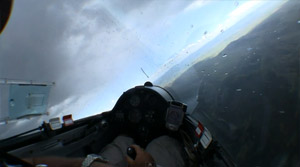
Glider Racing into Thunderstorm
http://www.youtube.com/watch?v=_gR8TPG-r_M
31 minutes of crazy cockpit footage of Day 1 in the
15-meter Gliding Nationals for 2011 out of Logan,
Utah. The first turn point took us right into a huge
thunderstorm. A few smart pilots flew to the east of
the storm and touched the turn cylinder. The rest of
us did not see that option and flew right into the
belly of the beast. Well more than half of the
gliders got caught in the storm and landed out.
This video shows pilot Bruno Vassel IV - B4 flying a
highly modified ASW20B into a small gap in the rain
trying to touch the turn cylinder and get out. Shows
dozen of lightning strikes WAY too close, really
cool looking rain, massive sink trying to get out,
getting very low over the mountains while still in
the storm in heavy storm front turbulence and rain,
radio chatter of other gliders landing out at both
airports and in fields in the middle of the storm, a
lightning strike right next to the glider and when
all hope was almost lost hitting an 11+ knot thermal
(1,100 feet per minute lift) that took the glider
back up to cloud base and saved the day.
Yes, a lot of people are going to criticize the
decision to even fly into this storm. You are
probably right. I wanted to share this because it
shows how flying into a "gap" in a thunderstorm
might look not all that bad but the storm can
quickly close in on you and things go from bad to
worse much quicker than you would like. Hope you
both enjoy and learn to stay away from thunderstorms
while soaring. :)
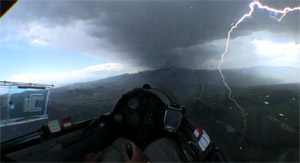
Glider Almost Hit by
Lightning in Thunderstorm
http://www.youtube.com/watch?v=f0Abl-izqZM
First Day of the 15-meter Gliding Nationals contest
- This lightning strike was during the infamous
thunderstorm where more than half of the contestants
landed out. Shows pilot Bruno Vassel IV -B4 flying
an ASW20B low and in the front side turbulence of
the storm northwest of Preston Idaho. Check out the
pilot's hands after the strike. Scared the crap out
of him! :)
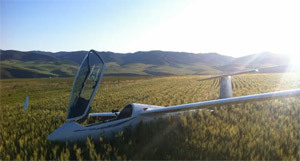
Glider Landing in Tall Wheat Field
http://www.youtube.com/watch?v=oJgSL4X6L-Y
Yes, I now know go for the dirt not the grass! Thank
you, lesson learned. This video was taken on day 5
of the 2011 15-meter Nationals out of Logan, Utah.
After a tough day getting around the course I took a
big gamble and went way deep into the second to last
turn cylinder to a very good looking cloud. It paid
off with a huge thermal that took me to cloud base.
That is the beginning of this video with me giggling
in delight. One problem, the day had died (I didn't
know this) and I still had 91 miles to make it
home...
This video shows pilot Bruno Vassel IV - B4 flying a
highly modified ASW20B in the final 10 minutes
trying to find lift over a small ridge and getting
forced out into the valley because of sinking off
the ridge. I spend a good amount of time circling
low trying to decide on the field and then landing.
PLEASE READ: Why did I pick the wheat field instead
of the plowed field? The plowed field was freshly
plowed within the last few days. The furrows were
deep and also running the opposite direction from
how I wanted to land - up hill. You can also see
that there is a large depression running in the
middle of the field effectively cutting it in half.
It was also much more angled than the wheat field.
The only gate I could see from the air was on the
corner of the wheat field where I came to a stop
within 30 feet. The biggest reason why I picked the
wheat field is that I thought I saw the crop was not
as tall but we all then saw that was wrong. OK,
lesson learned you can not judge crop height in the
air other than by color. Glad everything worked out
and the glider stayed going straight on landing.
Hope you enjoyed and please don't flame me too bad
for choosing the tall field, at least I shared the
video with you. :) Bruno
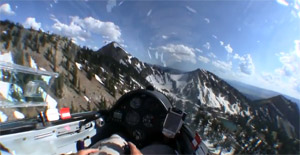
3 Gliders Racing Salt River Range in 2011 Nationals
Championship
http://www.youtube.com/watch?v=bL_5B1bCS2I
The full 42 minute version of 3 gliders racing each
other over Wyoming's amazing Salt River mountain
range during the 2011 15-meter national gliding
contest. The glider taking the video is an ASW-20B
piloted by Bruno Vassel IV. The glider shown at the
start of this video is John Cochrane (BB) flying an
ASW-27B and the second glider in the middle of the
video is Tim Taylor (TT) flying a Ventus 2a. All
gliders were fully ballasted. My 20B was 1157 pounds
and had a wing loading of 10.3 pounds. Hope you
enjoy! Bruno
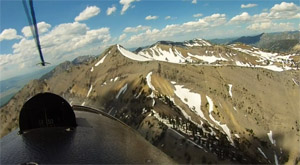
Gliding Salt River Range - 47 Min Raw Footage (glare
shield cam on a practice day)
http://www.youtube.com/watch?v=oh0oEUrdseI
July 14, 2011 Practice day for 15 meter Nationals
glider contest with a dozen gliders flying from
Logan northeast to north of Palisades Reservoir and
down south to Afton Wyoming. This video shows raw
footage (shot using a Contour+ video camera) of
pilot Bruno Vassel IV flying B4, an ASW-20B over
some spectacular scenery.
The first part shows the Palisades res and mountains
just south of the Grand Tetons. The next part shows
the ridge run south to Afton getting pretty low in
the process. The last part is just spectacular
showing ridge soaring the high parts of the Salt
River Mountains range just east of Afton Wyoming.
I debated cutting up this video and editing it into
something smaller but thought it would be
interesting to keep as a whole for when you are
bored on a long winter's weekend and feel like
watching some extended gliding. Enjoy!
Almost all
of the footage was taken with a Canon HF20 HD
camcorder sporting a fish eye lens and 12 volt 9 amp
hour external battery pack with a custom voltage
reducer to record 7+ hours in 1920hd. It was mounted
over my right shoulder using a RAM mount and two
small articulating arms. I really like this setup.
Some of the hand held videos and the video taken
from the glare shield is from a new Contour+ which
works ok but seems to get really hot in the sun and
seems to have a limited battery life of around 45
minutes when hot.
Thanks for watching and comments both positive and
negative are always interesting,
Bruno Vassel IV - glider "B4" (ASW20B)
|
|
Fun &
Interesting Soaring Links |
|
Below is a
collection of fun and interesting soaring and
aviation related links.
Click on the images to view the video or photo.
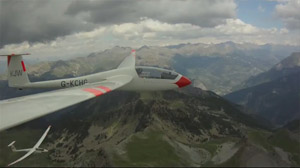
Awesomeness in the Alps, soaring from La Motte du
Caire! Filmed over 2 weeks with wave, thermal and
dynamic ridge lift providing the fuel for memorable
flights with spectacular views. - From Balleka's
Channel
http://www.youtube.com/watch?feature=player_profilepage&v=zwN7stIiq-U
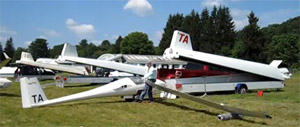
Glider One Man Rigging Demo - Frank Paynter
Evan Ludeman (T8) took this video of me assembling
my Ventus 2bx at Wurtsboro last week, using my
el-cheapo single-rig system. The video has not been
edited in any way, and assembly that morning was
actually a little slower than usual ;-)
http://www.youtube.com/watch?v=bcRipsiPgdk
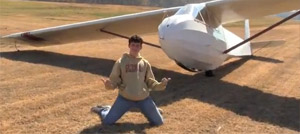
Preston Vihlen's 1st Solo at Hawks Nest in the 2-22.
Saturday, November 5, 2011 - Steve Vihlen
http://vimeo.com/31769711
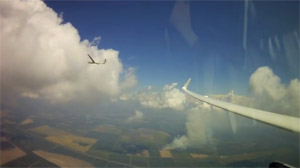
Fun Fly 2011 - Steve Vihlen
Memphis Soaring Society Fun Fly 2011. Lawrence
Field, AR
Club members gather for an end of summer fun fly
contest over the
weekend of September 9-11.
http://vimeo.com/29320454
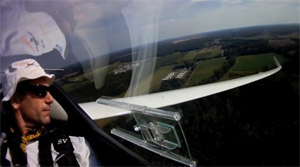
The Overcast Day - Steve Vihlen
A good turnout at Wolf River for a day of soaring,
however, less than forecasted conditions made for a
challenging day.
http://vimeo.com/29260963
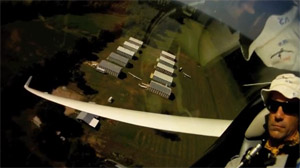
Hot Day at Wolf River - Steve Vihlen
A hot day at the field as three friends, SA, DY and
SV try to find cooler temps at cloudbase. Wolf
River Airport, Rossville, TN.
http://vimeo.com/27308526
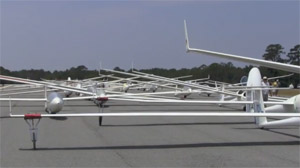
Cordele 2011
A short overview of the Std ClassNats/Region 5 South
contest at Cordele, Georgia. A great week with
fantastic weather.
http://vimeo.com/28302310
John
DeRosa's Aviation Web Pages - very nice
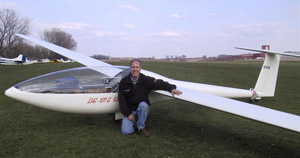
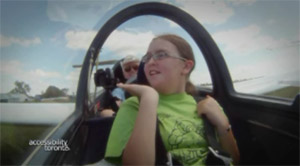
Freedom's Wings Canada -
http://www.freedomswings.ca
York Soaring Association -
http://www.yorksoaring.com/
Gliding through the air at 2,000 feet above the
ground can be extremely therapeutic.
Charles Petersen is shown sharing the excitement
with a thrilled passenger.
http://www.rogerstv.com/page.aspx?lid=237&rid=16&sid=4513&gid=86323
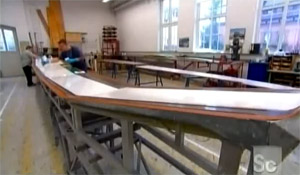
Discovery / Science Channel's "How It's Made"
Gliders episode
Schempp-Hirth Factory
http://www.youtube.com/watch?NR=1&v=I_atJwXxcrU

Small car, Small motor, Big Launch
Cool idea! Luka Znidarsic's FES (Front
Electric Sustainer) gets a quick autotow launch from
a small car with 105 hp engine to several hundred
feet, then uses the FES to climb out.
http://blog.cafefoundation.org/?p=4759
http://www.front-electric-sustainer.com
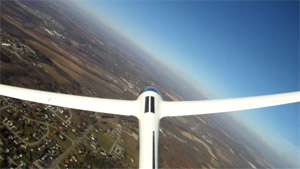
Sean Fidler, ASG 29, GoPro Hero HD, November 1,
2011
The best part is the high-speed pass at 4:35.
http://vimeo.com/31470116
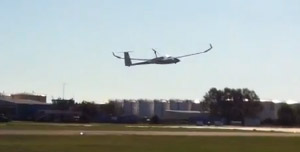
DG-1001TE Self-Launch
The first self-launch of the DG-1001TE. It is
normally not a self launcher, but rather a "turbo" /
"sustainer". But it seems to have plenty of
power for self-launching.
http://www.youtube.com/watch?v=oKc3QFM8xw8
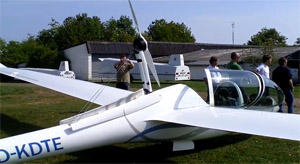
DG-1001TE Flight
Excellent video showing the new DG-1001TE.
http://www.youtube.com/watch?v=uQrQ4EtJoGc
Details on the
DG-1001TE on the DG web site:
http://www.dg-flugzeugbau.de/dg1000te-e.html
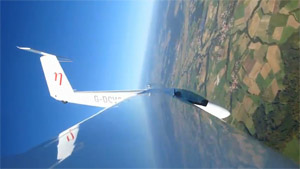
German Aerobatics training seminar
http://www.youtube.com/watch?v=h3TGeJWjig0
http://www.youtube.com/watch?v=DeBAeW62_JI
http://www.youtube.com/watch?v=-BhHsy2D8i0
http://www.youtube.com/watch?v=a_kz9H8NsXc
http://www.youtube.com/watch?v=w_7AaYvoS-Q

Celebrating 50 years of human-powered flight
That is Derek Piggott as the pilot
http://www.guardian.co.uk/science/2011/nov/09/50-years-human-powered-flight
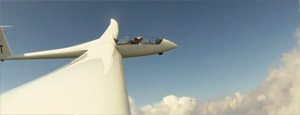
Clelia's 98th Birthday Glider Flight
http://www.youtube.com/watch?v=USXhq2EPfFU
http://www.goochlandgazette.com/index.php/news/article/a_soaring_birthday_gift/26413/
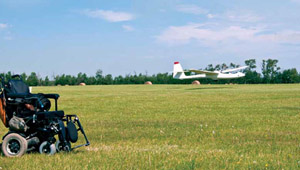
Discover Gliding
From New Mobility - The magazine for active
wheelchair users
http://www.newmobility.com/articleViewIE.cfm?id=11998
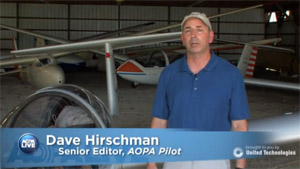
AOPA - Challenges: Powerless flight - A
fixed-wing pilot goes motorless
By Dave Hirschman
http://www.aopa.org/members/files/pilot/2011/november/challenges_powerless_flight.html
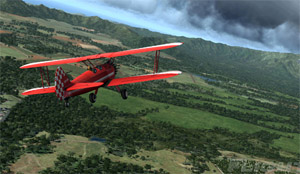
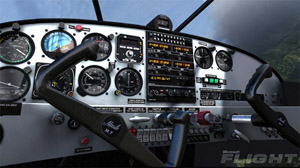
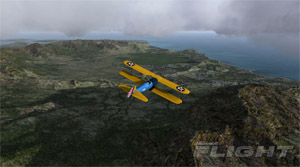
Microsoft Flight
Microsoft is working on a new PC flight simulator
game called Microsoft Flight. It is not
available yet, but an announcement is expected in
December. Thank you to my brother Kevin
(Microsoft employee) for clueing me in to this!
http://www.microsoft.com/games/flight/
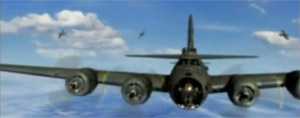
"Old 666"
http://voxvocispublicus.homestead.com/morrow.html
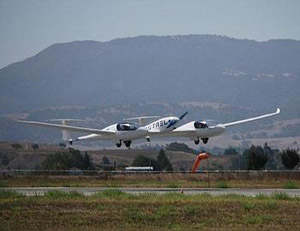
Electric Airplane Wins $1.35 Million Aviation
Prize
The largest prize in aviation history was awarded
Monday to an electric airplane made in Slovenia that
won NASA's Green Flight Challenge.
The first place prize of $1.35 million was awarded
to team Pipistrel-USA.com of State College,
Pennsylvania for their flight in the Taurus G4, made
by a privately owned Slovenian company named
Pipistrel.
The second place prize of $120,000 went to team
eGenius, flying an electric aircraft developed at
the Institute of Aircraft Design of the University
of Stuttgart, Germany.
http://www.ens-newswire.com/ens/oct2011/2011-10-04-01.html

Private Rocket Launch to 121,000 feet
On September 30, 2011 at 11:08am, Derek Deville's
Qu8k (pronounced "Quake") launched from the Black
Rock Desert in Nevada to an altitude of 121,000'
before returning safely to earth. Above 99% of the
atmosphere the sky turns black in the middle of the
day and the curvature of the earth is clearly
visible.
http://www.youtube.com/watch?v=rvDqoxMUroA

Lake Keepit Soaring Club Newsletter -
Excellent!
Lake Keepit, Australia
http://www.keepitsoaring.com/LKSC/index.php?option=com_content&view=section&id=16&Itemid=105

Oudie Competition Tutorial for Area Assigned
Tasks
by Richard Frawley
http://www.cumulus-soaring.com/seeyou.htm#Downloads
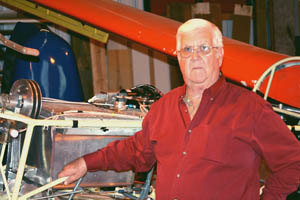
Lyle Forsgren's homebuilt motorglider project
http://www.eaa.org/experimenter/articles/2011-11_project_patrol.asp
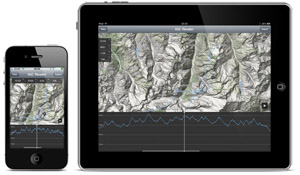
IGC Reader is an iPhone, iPod Touch,
and iPad application to view and play IGC flight log
files. You can open IGC files from websites or
import them via iTunes and other supported
applications.
http://igcreader.com/

Hitler learns
that his application for Soaring Gold Badge has been
rejected. Funny!
http://www.youtube.com/watch?v=TZvqSXmPB6Y
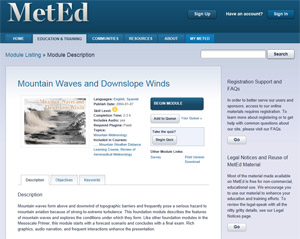
Mountain Waves and Downslope Winds
Free online training course
https://www.meted.ucar.edu/training_module.php?id=140
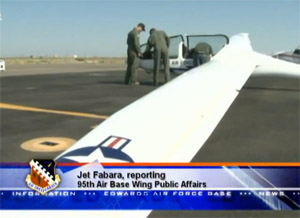
445th FLTS tests new USAF Academy glider
With the U.S. Air Force Academy's recent purchase of
19 new gliders to replace some of its aging gliders,
the 445th Flight Test Squadron at Edwards Air Force
Base has the job of testing one of the academy's new
TG-16A (DG-1001) gliders.
http://www.youtube.com/watch?v=bsV3OXDmWag

Minnesota
glider pilot Bob Hanson flying in Grenoble in a
DuoDiscus
http://www.youtube.com/watch?v=sxJoJec0u3s

Peep Lauk's beautiful self-launching flying wing
sailplane in Estonia
http://public.fotki.com/alari/flying_wing/
http://www.youtube.com/watch?v=h6GWK0l7pCg
http://www.englishrussia.com/forum/viewtopic.php?f=2&t=7969
http://www.purilend.ee/node/3413
http://www.youtube.com/watch?v=WsJlHtK5Wok
http://www.youtube.com/watch?v=Ps7BdZFHsFw
|
|
Coming
Next Month |
-
PowerFLARM Status Update
-
ClearNav variometer status update
-
LX9000 Demonstration Video
-
New PDF format?
-
More fun links and soaring news from around the
world
|
|
Wrap
Up |
Thank you for
taking the time to read this newsletter. I hope you
have found it interesting. If you did, please tell
your friends about it. Please mention it in
your local soaring newsletter. Please direct
them to:
http://www.cumulus-soaring.com/newsletters.htm
I consider myself a servant. Please let me know if
there is anything I can do to help you find the
right soaring instruments for your needs, or help
you learn how to use an instrument or software
product. Also, let me know if you have any
suggestions for products or services to add to my
web site, or ways that I can serve you better.
I feel blessed because I love my job. I enjoy
serving the soaring community. Like you, I am
passionate about soaring. Thank you for your
business, I sincerely appreciate it.
Fly Safe,
Paul Remde
|
|

